Highlights of the Amsterdam Pipe Museum
Author:
Don Duco
Original Title:
Hoogtepunten uit het Amsterdam Pipe Museum
Publication Year:
2020
Publisher:
Amsterdam Pipe Museum (Stichting Pijpenkabinet)
Hookah bowl with enamel
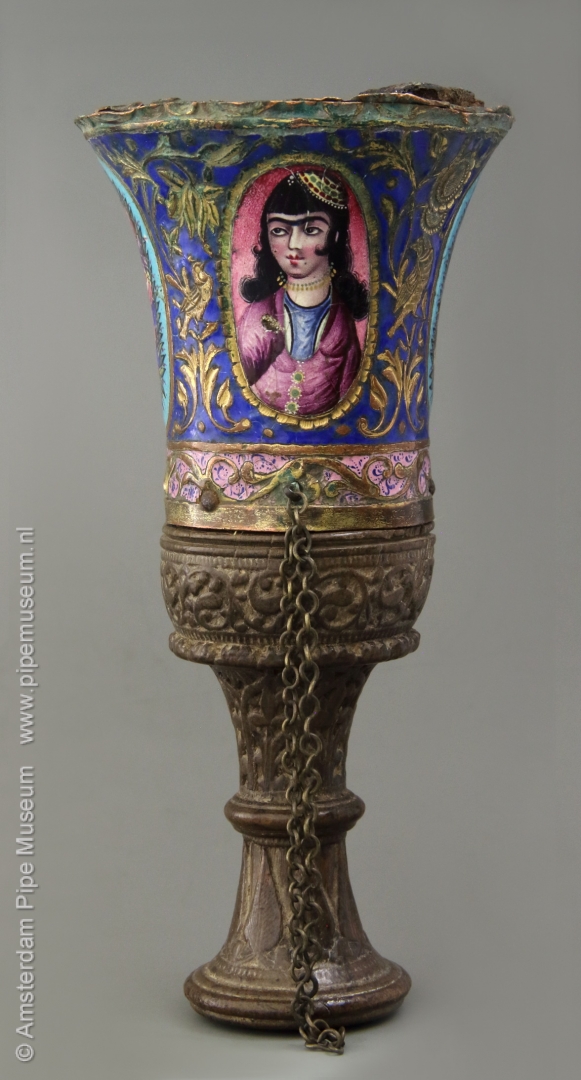
This hookah bowl is one of the most frequently depicted objects in our museum collection. The reason is that it comes from the collection of the former Seita museum in Paris. Since it was founded in the late 1930s, this object was part of the collection. Because it is not only a rare object, but also exclusive and colorful, it was chosen as one of the museum's mascots. The former collection number "122" is still on the base, framed in white ink by the characteristic four lines.
The object has a height of sixteen centimeters and consists of two materials. The core is made of wood and has a chalice-shaped bowl on a sturdy base that tapers downwards. The strenghtened underside serves to clamp the object on the rising stem of the water pipe. The outside is decorated with simple notch cut ornament. Under the bowl we see a circular belt with winding leafy branches, on the stem are fields filled with hyacinths, symbol for renewal and fertility, closed at the bottom with a series of stylized cypresses, the tree of life, symbol of eternal life.
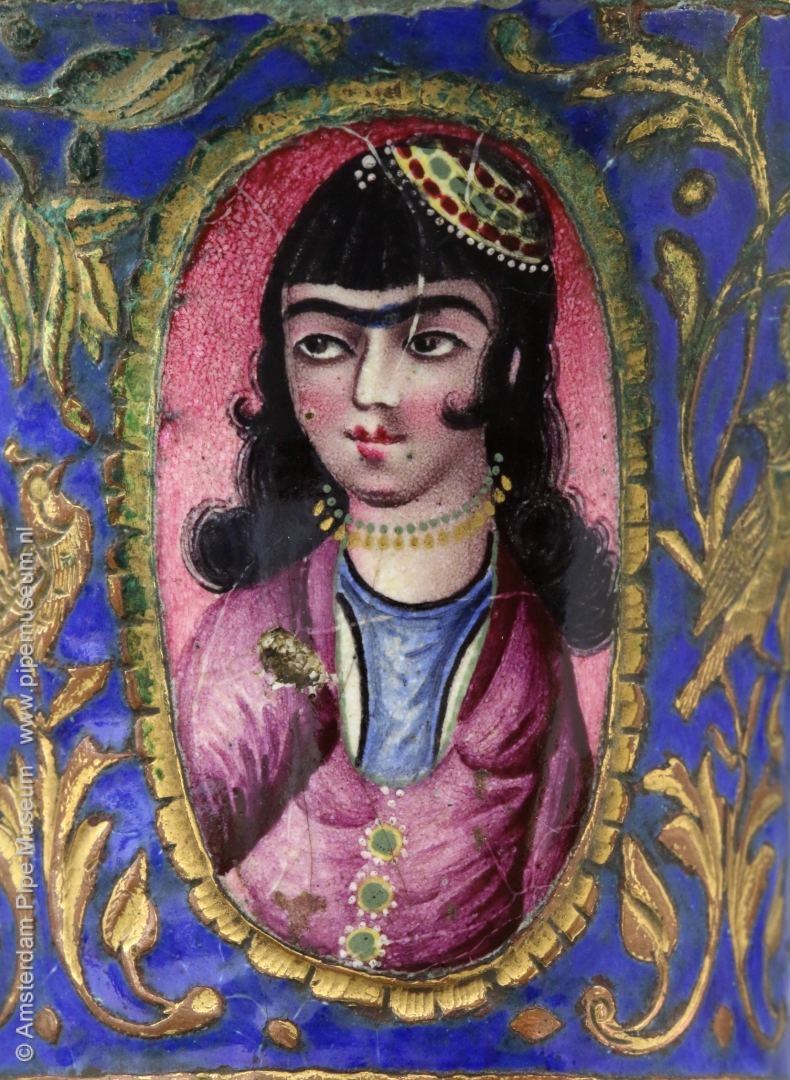
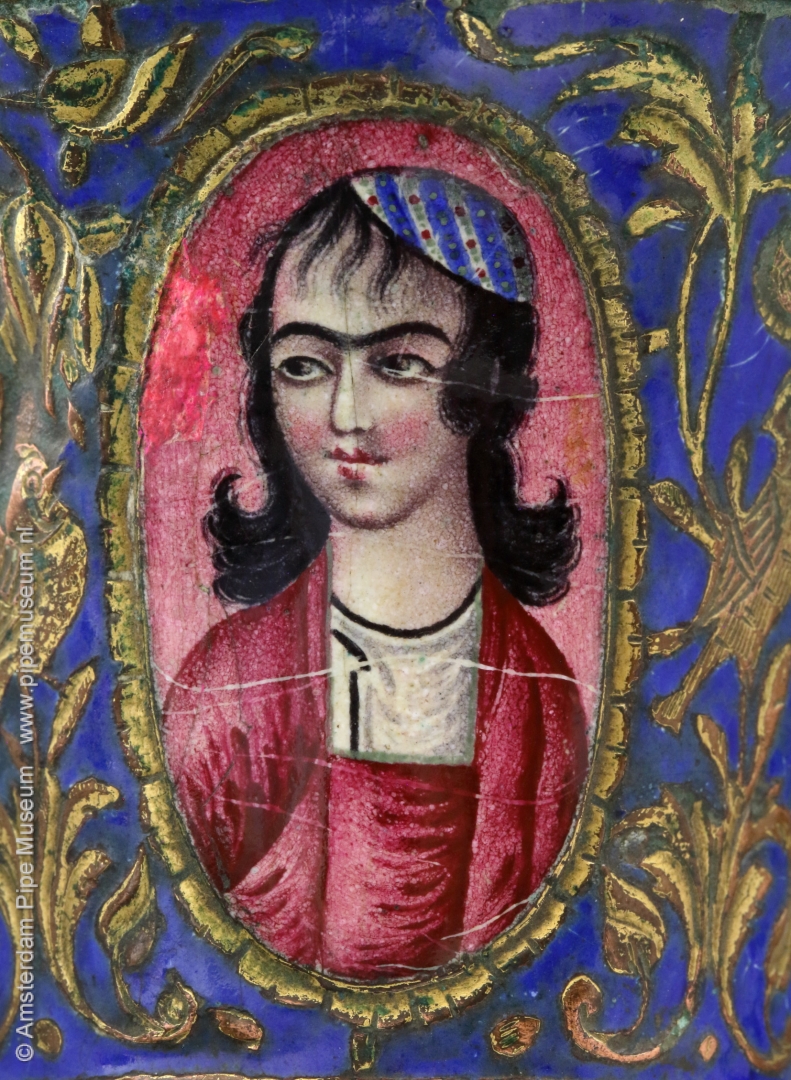
The bowl part has been given a copper cladding on the outside, on which a decoration in multi-colored enamel has been applied. This polychrome element contrasts beautifully with the gray-brown base and forms the strength of the object. This enamel work around the bowl shows four standing ovals, two of which with the bust of a Persian woman. As a beauty ideal, she has convincingly continuous eyebrows, something we now look a bit uncomfortable with. Two smaller medaillons show blooming flowers. All around these elements the space is filled with ornamental work of branches with birds in gold against a blue background. Along the bottom edge of the bowl there were originally four eyelets, one of which has the brass ornamental chain still present. A thick carbon deposit has been formed on the inside of the bowl as a result of years of intensive smoking.
Such hookah bowls crowned the Persian qalyan, the water pipe with a drop-shaped reservoir that stood on the ground in a tripod. The smoke was usually brought to the mouth through a flexible hose. The object is a characteristic luxury item that dates back to the Qajar period between 1796 and 1925. Qajar, originally of Turkish descent, was at that time the royal dynasty in Persia, present-day Iran. It was a period with a lot of attention for arts and crafts. Such enamel work is one of the hall marks of this dynasty.
Amsterdam Pipe Museum APM 22.977
Water reservoir in bidri work
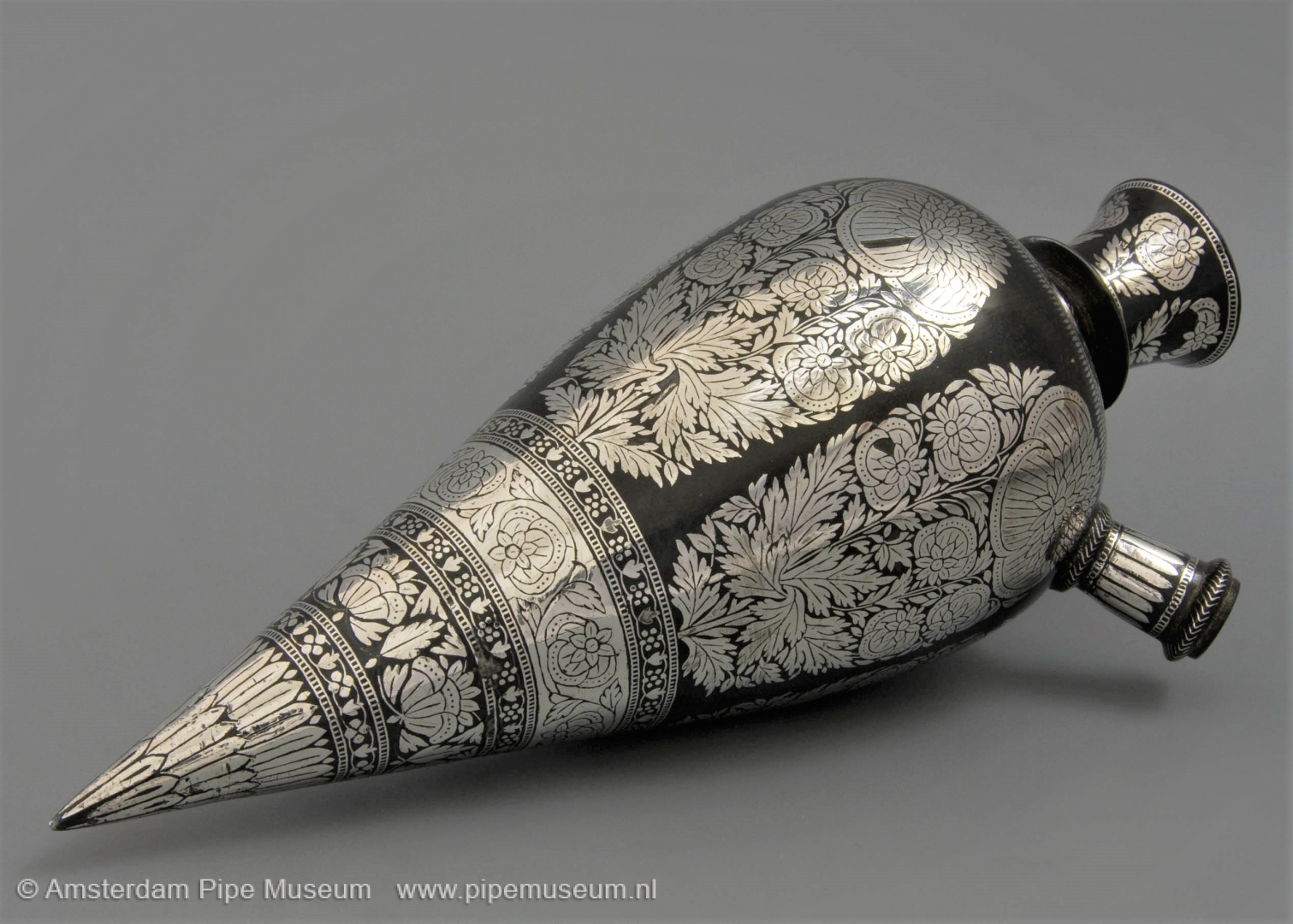
The most important part of the water pipe or hubble-bubble is the reservoir that contains the water for cooling the smoke. Usually this is also the base of the water pipe. Generally, there are two types. The most famous is the bottle with a flat base that stands on the table or on the floor. They are in use in Turkey, but mainly in India. In Persia it was more common to use a drop-shaped reservoir, originally a hollowed-out coconut. Initially, the tip of the reservoir was poked into the ground when the pipe was not being smoked. Later on, an openwork tripod will be used for this purpose, in which the water pipe is placed. Over time, the pipe's status value grows. The original coconut is replaced by a metal reservoir in which the oval shape remains visible. That is the type to which the object discussed here belongs.
For the manufacture of the water reservoir, also called base or hookah base, a specific technique has been used typical of luxury objects. It is the so-called bidri work. This bidriware comes exclusively from the Bidar region, centrally located in the southern part of India. There, a unique handicraft in decorative metalwork developed since the fourteenth century and has remained famous ever since. In forging decorative utensils a small portion of copper and zinc was added to the iron, so that it rusted less quickly. Subsequently, the objects were provided with a nice pattern on the visible side, often geometric but also floral. That pattern is cut into the metal and then inlaid with pure silver. After sanding and polishing, both metals form a perfectly smooth surface. Finally, the iron is blackened with a special acid. The result is a beautiful interplay between two related metal tones, the silver contrasting with the black.
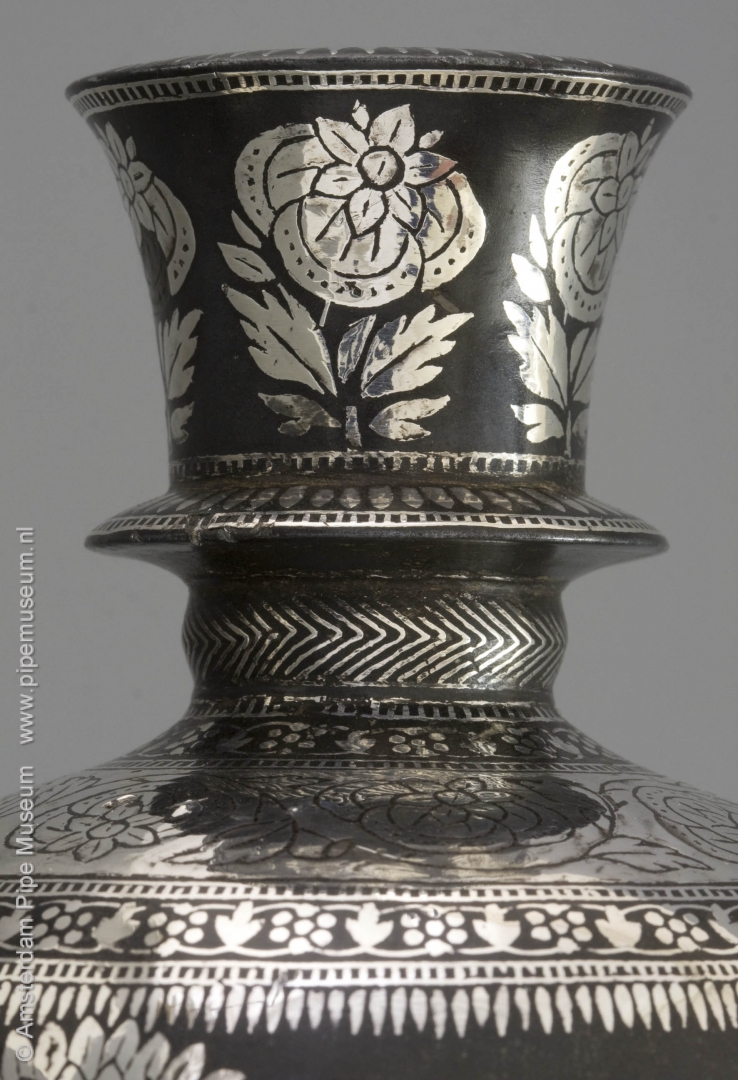
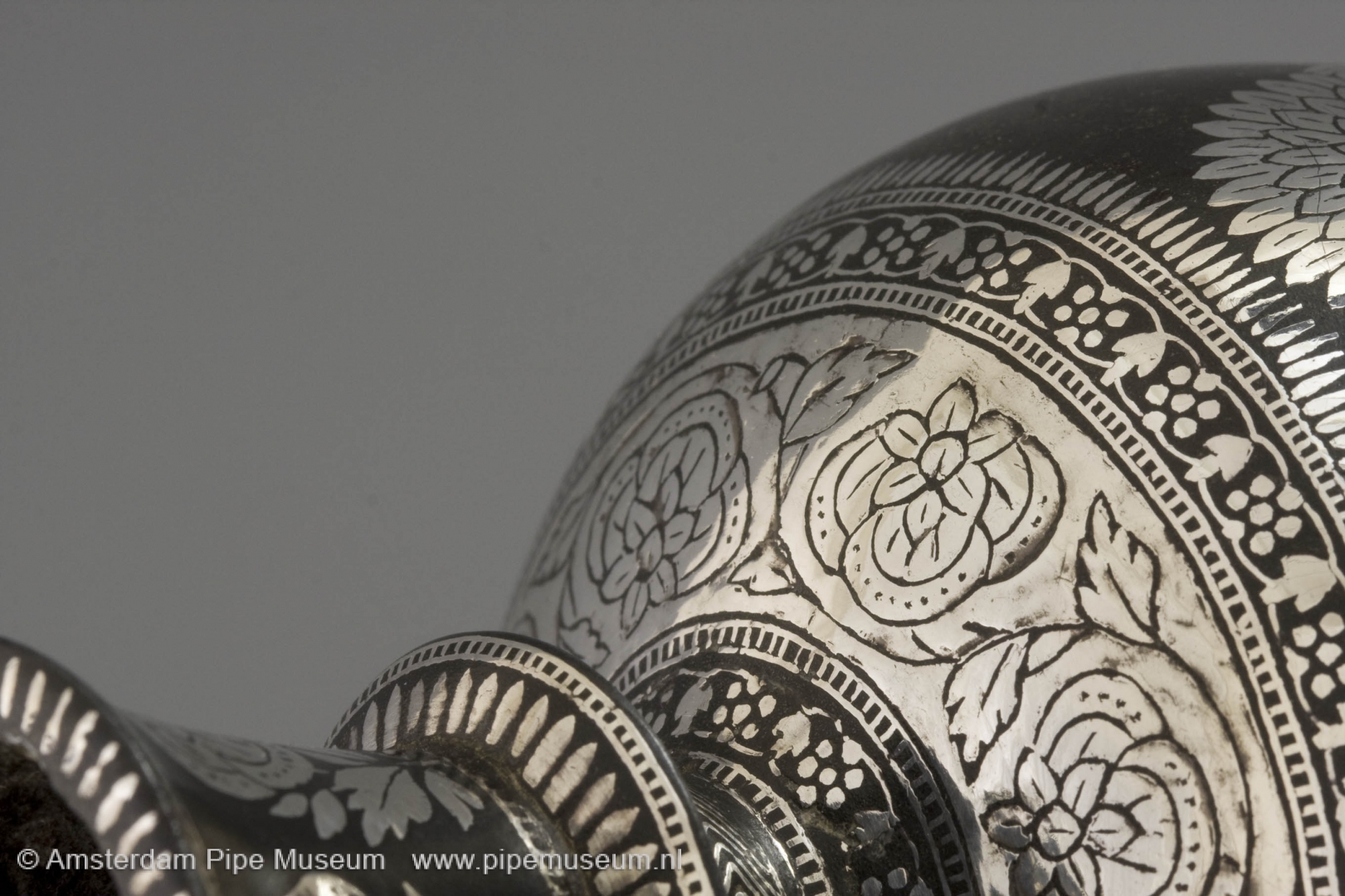
A rare feature of this water pipe reservoir is the so-called Persian shape, which was not really common in India as noted. Nevertheless, this water reservoir has been given a powerful drop shape, ending in a point at the bottom and a convex top with a neck with a protruding neck. The conical stem base is located on the shoulder. The shape of these reservoirs varies from slender and elongated like this one to stocky and powerful, but always with maximum tension.
The decoration in bidri technique on this reservoir is remarkably extensive and above all meticulous. The main motif is formed by five upright ovals filled with fine foliage and blooming roses. Over the shoulder and along the underside we see an alternation of bands with flower meanders and lilies, separated by circular rings with dots or flower buds. The liveliness of the decor is further enhanced by the fact that the shoulder area and the top of the three straps at the bottom seem to have a reverse technique: silver as a background with the ornaments of iron that remain as thin lines. This work is a sign of the great craftsmanship of the maker, it adds more silver and is therefore more expensive and luxurious, but above all it increases the contrast in the object.
In this case, the high quality is also proven by the fact that the iron still has a beautiful matte black shade after many years, with a hint of brownish rusty color. The contrast with the silver is still perfect. Many pieces lose their deep black color over time or by polishing the silver, which diminishes the effect. It is almost impossible to set an exact age on this object. The technique is so traditional that it has been carried out unchanged for hundreds of years by artist-craftsmen trained on site. Yet this water pipe reservoir must date from the mid-nineteenth century, the time when Persia made the most luxurious goods itself during the Kadjar dynasty, but also imported them, such as with this object.
Naturally, this hookah included an upright stem on which a detachable pipe bowl was placed and a second wooden stem for drawing the smoke. Unfortunately, such parts have almost always been lost. The valuable reservoirs were preserved and when they came back into use, new woodwork was turned.
Amsterdam Pipe Museum APM 21.200
Water pipe in horn shape
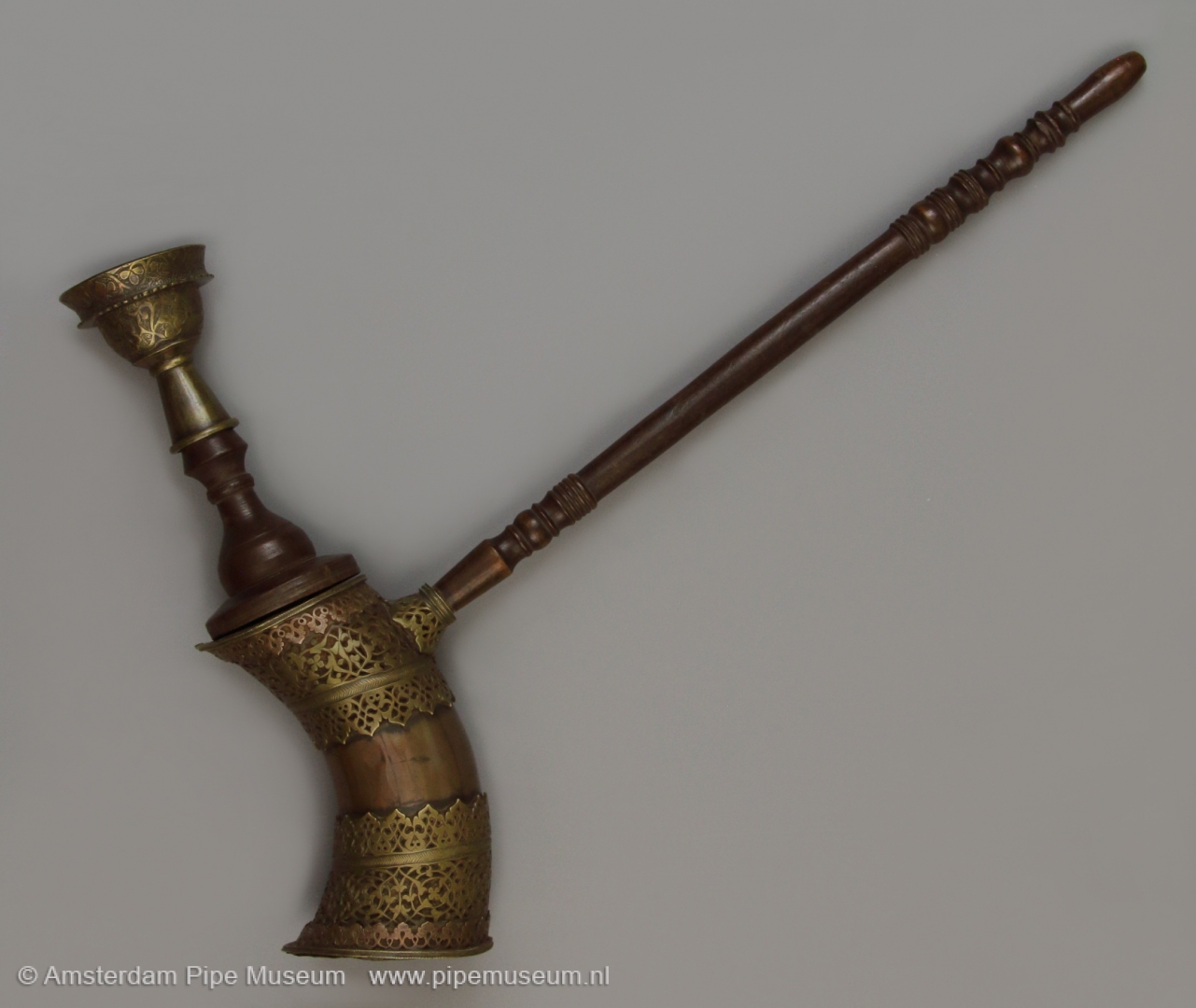
The water pipe has been known and used in Asia since the early seventeenth century. The need to cool the smoke in warm climates stimulated this invention. The water pipe consists of two main parts: the bowl to burn the tobacco and a bottle of water to cool the smoke. A stem connects the bowl to the reservoir, a second acts to take in the smoke.
Understandably, a simple bottle was initially used as a reservoir. In regions where these are scarce, materials are used that are locally available. This water pipe is a good example. Originally a piece of horn from a carabao or other quadruped was used as a reservoir. A piece is simply sawn off from the base of the horn into which a wooden bottom is applied. This creates an unbreakable reservoir that has two holes at the top. The natural opening in the horn is intended for a plug for mounting the pipe bowl, a second small opening is drilled on the side for a separate stem. This is how a pipe is born with a particularly striking silhouette that, as you can imagine, will become specific to the region where it was conceived.
The use of available natural materials thus dictates the tradition in form and appearance. When these materials are later exchanged for others, the original design often remains. The water pipe illustrated here is a fine example of this development. The reservoir still shows the original curved shape of the animal horn, but has now been created in copper. This has been done in an extremely careful manner, especially when we consider that the bend in the reservoir is not easy to imitate. This resulted in a copper water bottle that is embellished along the base and top edge with thick brass plate in which strips with geometric patterns were cut out. Given the thick brass, this must have been a time-consuming job, but the contrast in colours between red and yellow gives a beautiful and playful result. This is reinforced by the fact that a narrow band with red copper ornaments is attached to it, again along the base and top edge.
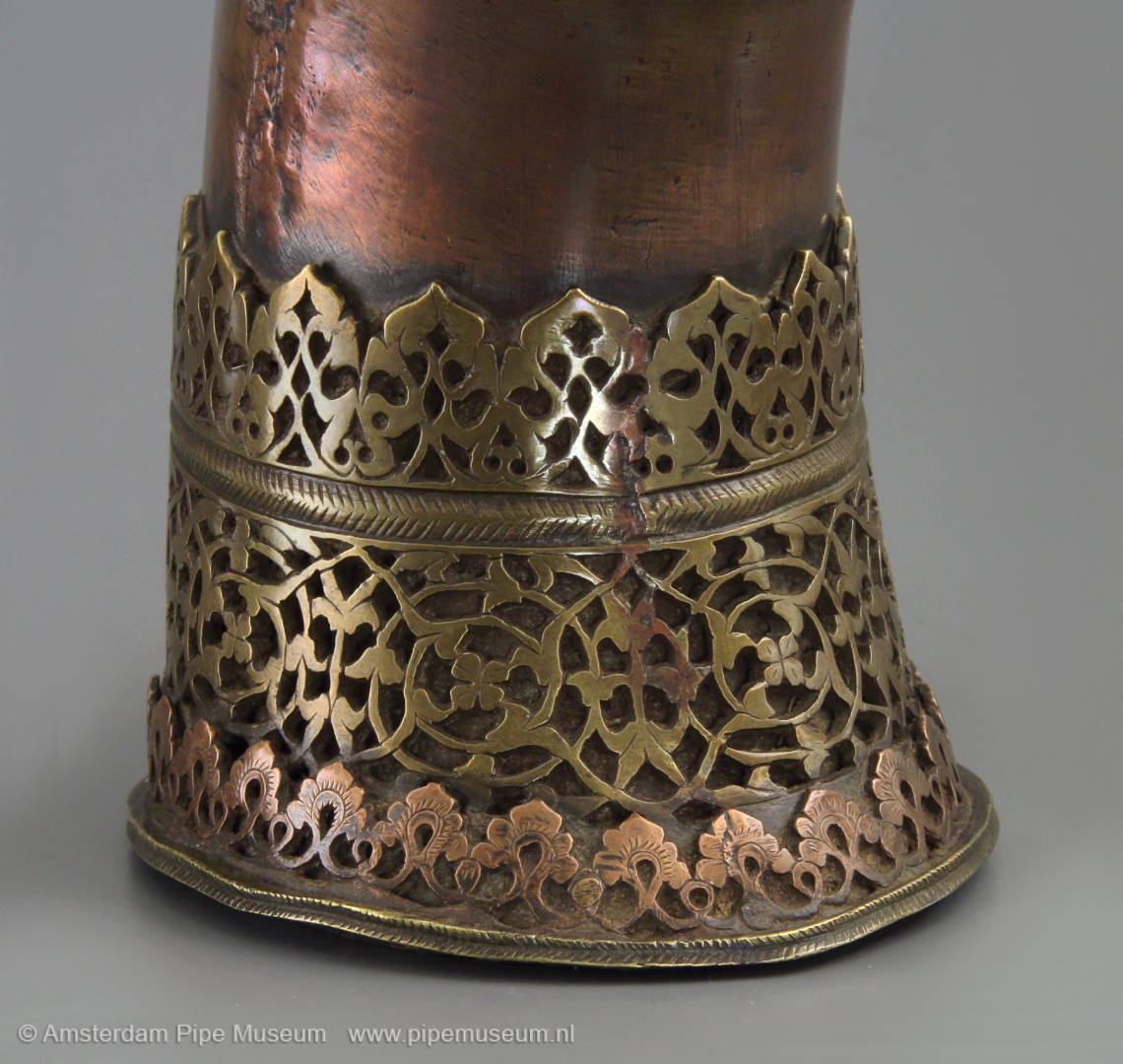
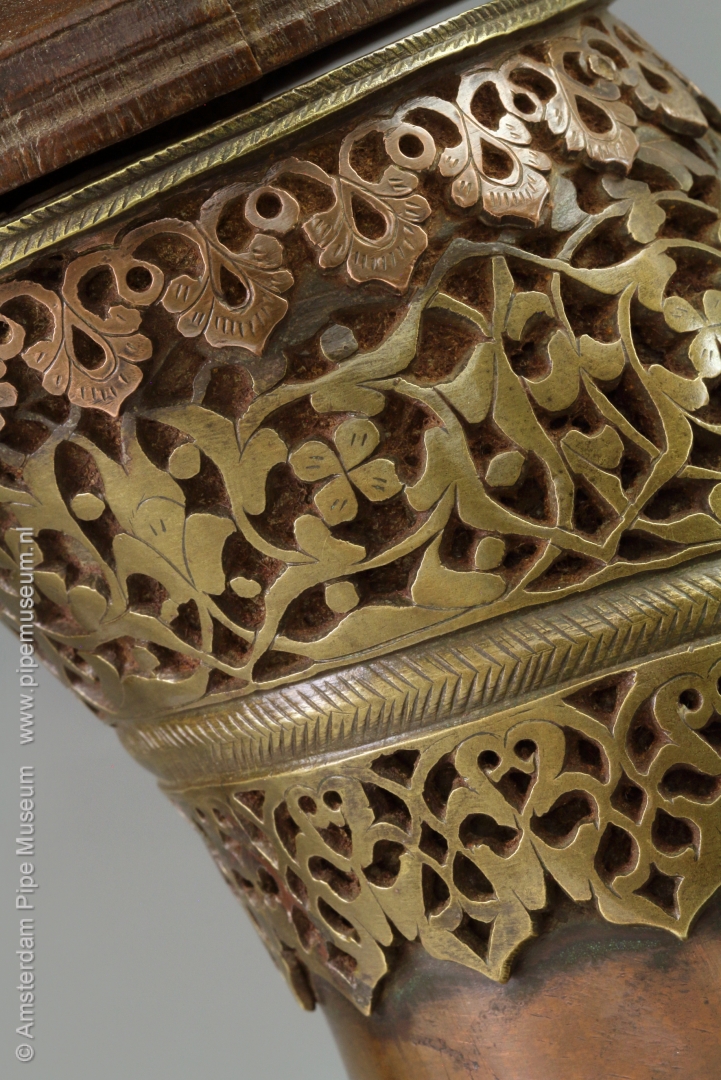
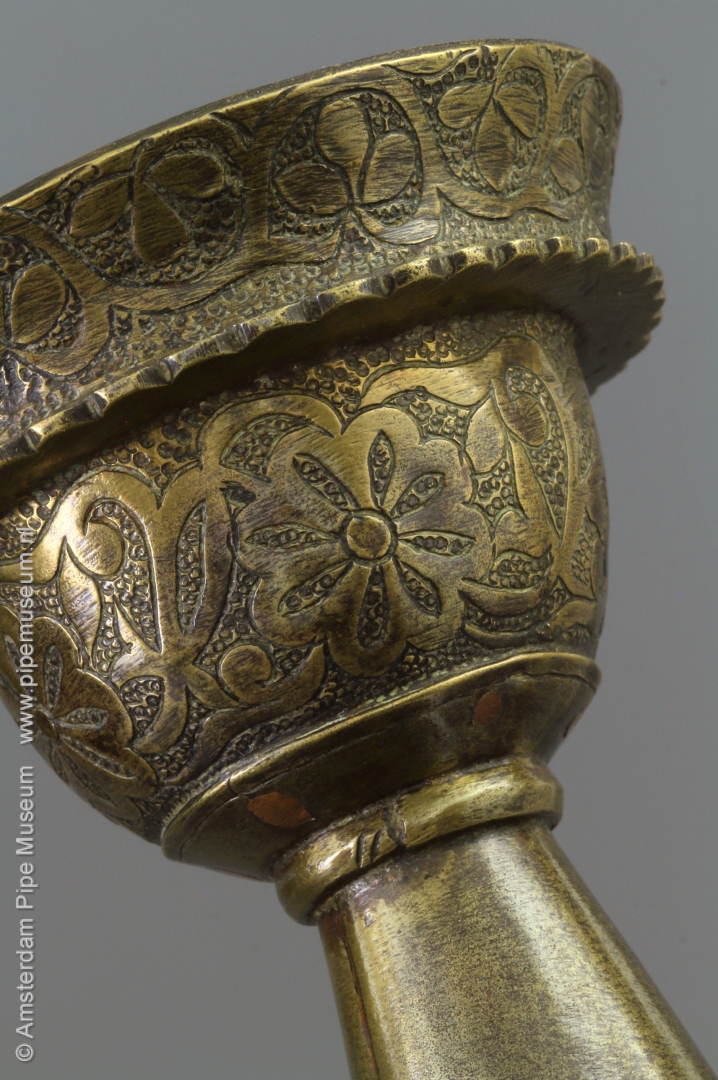
The discussion of how much time elapses between the birth of the buffalo horn prototype and the later metal ones is not an easy one. This question concerns the duration of a tradition, the change of material, but also general shifts in culture that lead to other materials and new techniques being used. Interestingly enough, our museum houses a second example of this type of pipe, also made of metal but now fitted with an embossed base depicting figures. That pipe clearly dates from a later stage, as the imitation of horn in copper now dictated a decoration in relief.
The origin of this pipe is in Northern India in the Ladakh region. However, some specimens are known from neighboring areas as far as Lahore in Pakistan. It is unknown whether those copies were made there or whether they ended up there as merchandise. Although the dating of the basic shape presumably goes back to the seventeenth century, this is probably a nineteenth century copy. The bizarre shape of the reservoir together with the protruding bowl and stem give the pipe such a specific silhouette. This makes it a water pipe that stands alone and has no direct counterparts. That is exactly what a museum collection is looking for.
Amsterdam Pipe Museum APM 24.492
The tobacco pipe in Northern Siberia

There are areas in the world where resources are scarce. When people living there wants to make a pipe, the choice of material is limited. This applies, for example, to the Tongoosk, an Arctic tribe in Siberia. They live with a minimum of materials that they find in nature. Once tobacco became known in this remote region by trade, smoking became a popular form of recreation. While the tobacco itself was being imported, the pipe developed its own tradition with its own design. We now see these pipes as a remarkable and interesting ethnographic object.
Tongoosk pipes are usually composed of various materials. The stem is made of a soft wood and always has a slightly upward curve. These stems often have a diamond-shaped diameter that tapers towards the mouthpiece. Because it is not possible to pierce the pipe wood, the stems are made in two halves, each of which is hollowed out. After the flue has been cut out mirrored in both halves, they are tied together with a simple piece of wire or cord. This cord gives the pipe its characteristic appearance and, in addition to a binding function, also has a decorative value. Usually this wire is made of fish skin. The literature speaks of seal skin, but the specimen shown here seems more to be a gut string or tendon.

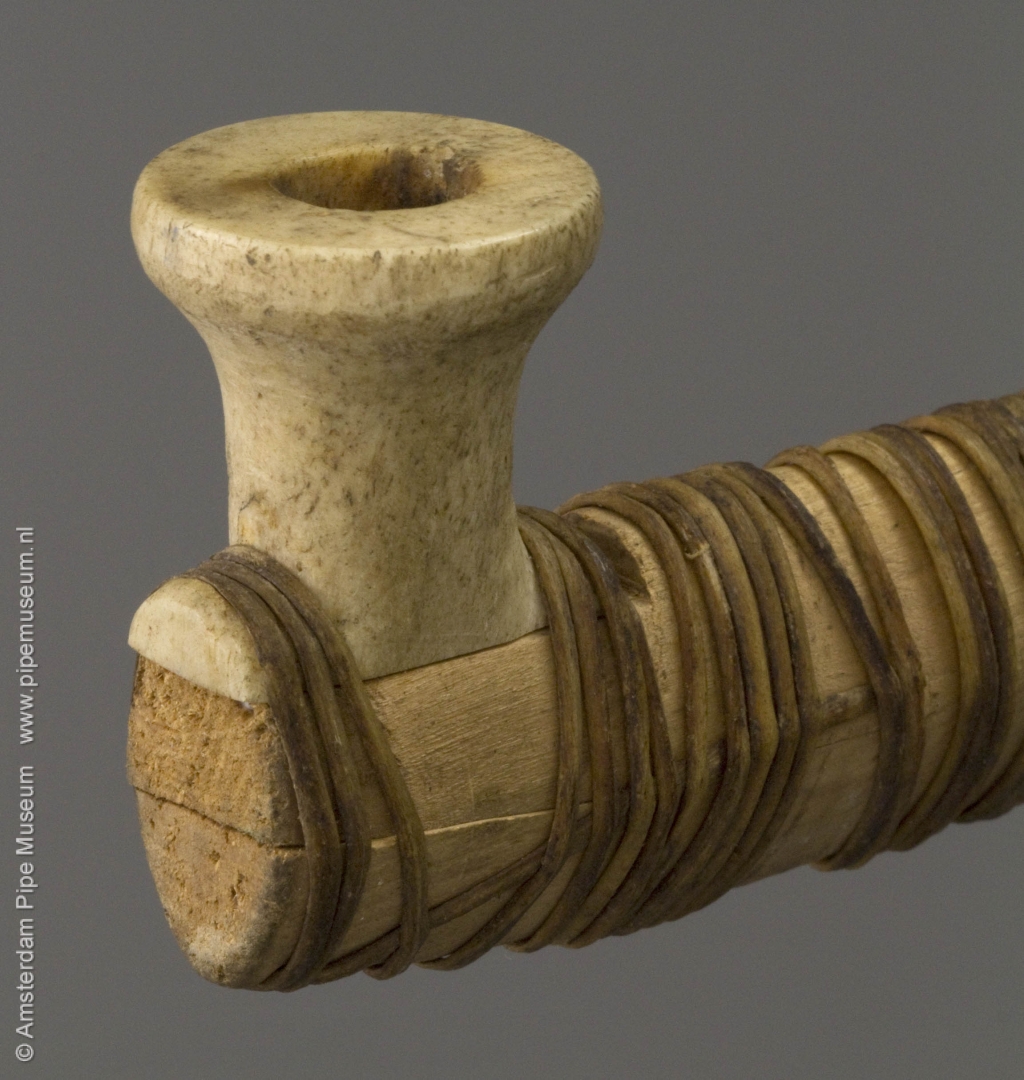
A better fire-resistant material must be sought for the pipe bowl. Sometimes metal is used, such as copper or lead. In this case, it is walrus bone, cut into a specific shape. The bowl is funnel-shaped and small, the size of course corresponds to the scarcity of tobacco in that region. A small amount of tobacco can be burned completely on the funnel-shaped pipe bowl. This fits in well with the economical way of life of the people. A filter of grass or animal hair is inserted into the stem of the inner bowl and is intended to ensure that the tobacco completely burnt to ashes and is not disappearing in the smoke tube. Such a filter against so-called flying ashes is sporadically used in other cultures, such as in the Papua.
In this case, the pipe is provided with a separate mouthpiece which is also cut from walrus bone and even has a button-shaped nozzle. This mouthpiece makes the pipe significantly more durable than using the soft wood of the base material.
The term Tongoosk has long become very outdated and is only rarely used. In fact, Google only finds this word in two places, in our museum and in the British Museum. In both cases, the name is based on the description that the famous collector William Bragge gave to these types of pipes in 1880. Since Tongoosk is actually a strongly derogatory Russian term for an ethno-linguistic group in North-East Siberia, the name has long since changed into Evenki.
Much Eskimo arts and crafts are defined as Alaska or more broadly North American. This object is therefore an exception because it is of Asian origin. In fact, the Evenki are not even counted among the Inuit because they speak a language developed from Mongolia, most related to the Yenisei languages around the Yenisei River in central Siberia. The date of this specimen will be in the first quarter of the twentieth century, but such pipes have been in use in the same shape by the Evenki for much longer.
Amsterdam Pipe Museum APM 19.820
Standing crane as a water pipe
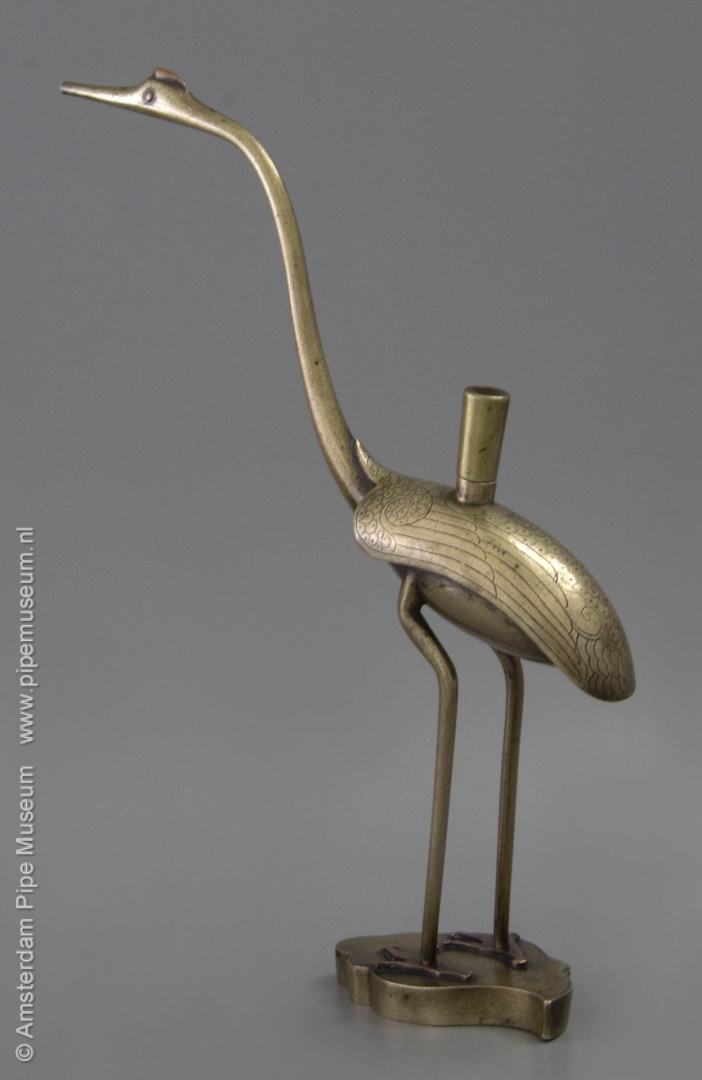
As an alternative to the regular tobacco pipe, the Chinese smoker has always had access to a water pipe. Most common are the smoking sets made from a specific Chinese metal, consisting of a rectangular box containing a handy water pipe next to a small tobacco jar. Between the two objects there is a hook with an eye for carrying the object on a cord from the belt. The smoking tools are also stored there: tweezers, a spike and a brush. Anyone with any interest in tobacco pipes knows these smoking accessories or travel sets.
The common hookahs are made of pakton, an alloy of iron, nickel and copper. That particular alloy most resembles our alpaca, although we tend to speak of silver although that is never the case in China. They name the alloy as copper. Pakton can be polished to an almost silvery shine. It will come as no surprise that an entire industry of these pipes developed. Inevitable new inventions emerged from that industry. Such a rare curiosity is discussed here.
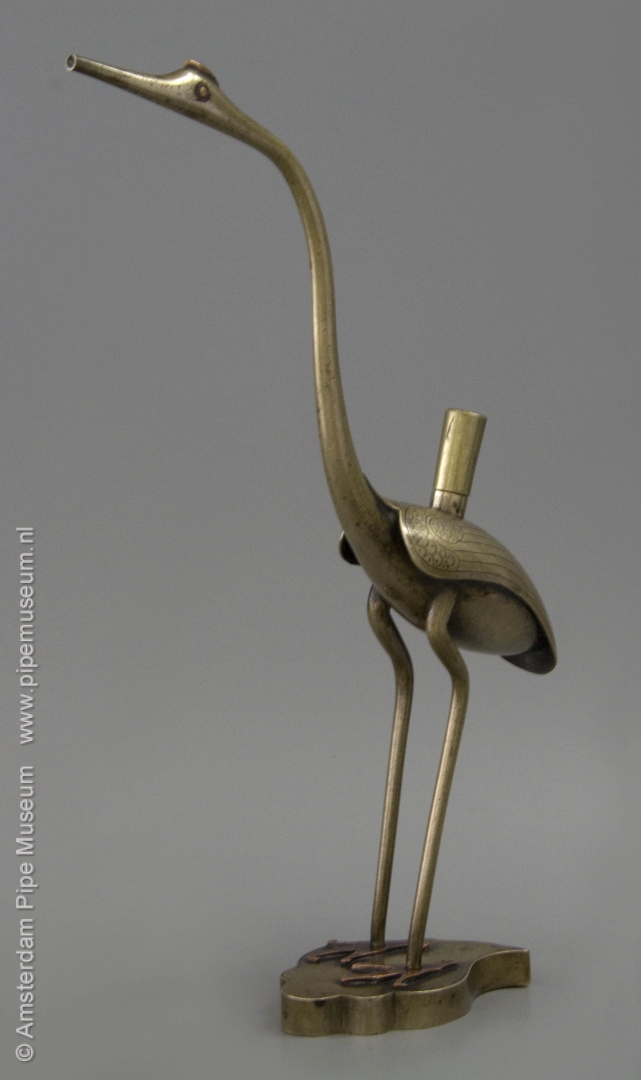
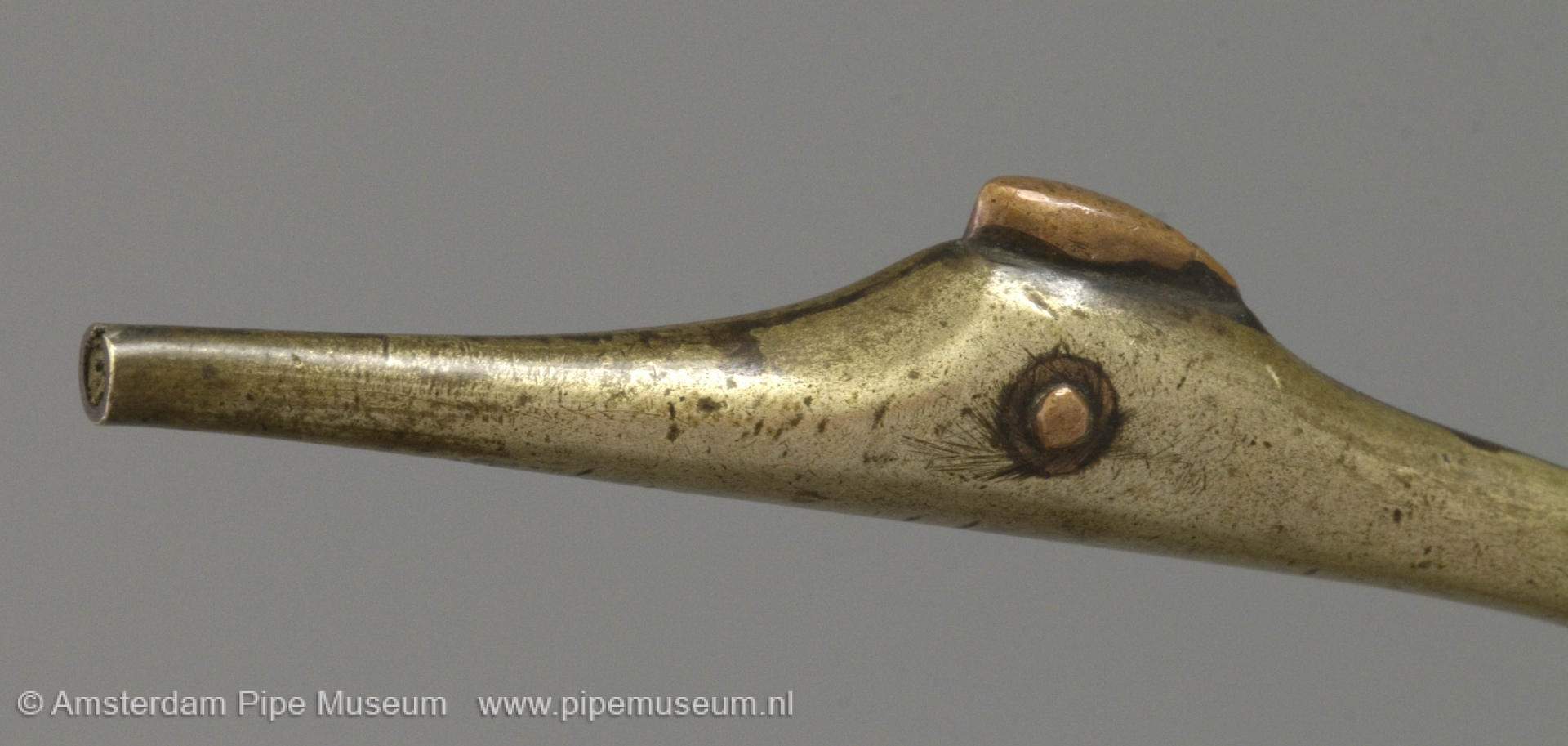
In the factories for pakton objects, hookahs are made in figural form only sparingly. That is not surprising, because with a figural object the practical and handy aspect of the smoking set was lost. It resulted in a curiosity like the pipe depicted here in the shape of a standing crane. The animal rests with its long legs on a lotus leaf with a lobed contour, which forms the stable base of the object. The bird's high legs carry an oval-shaped body with a thin, long, slightly curved neck and slender bird's head. The beak forms the mouthpiece of the pipe. On the back of the bird we see engraved markings that depict the plumage in a stylized way. The bowl insert is also fitted at this location with a separate cylindrical detachable pipe bowl. Internally, this bowl has a geometric grid to burn the finely chopped tobacco. The carefulness of the craftsmanship is once again proven with red copper accents on the eyes and crest as well as on the animal's toes.
In China, the heavenly cranes are beloved animals to portray. The tian-he or the blessed crane is one, the other is the xian-he or the messenger of wisdom. The legendary Taoist wisdom was carried on the back of a crane. The question is whether the smoker at the time was aware of this highly symbolic and lyrical information. If not, they may at least have enjoyed the original design of this pipe and undoubtedly impressed other smokers. However, given its rarity, the bird pipe has not been a common item; it took many years before this creation was represented in our museum collection.
Amsterdam Pipe Museum APM 22.796
A golden kiseru for ladies
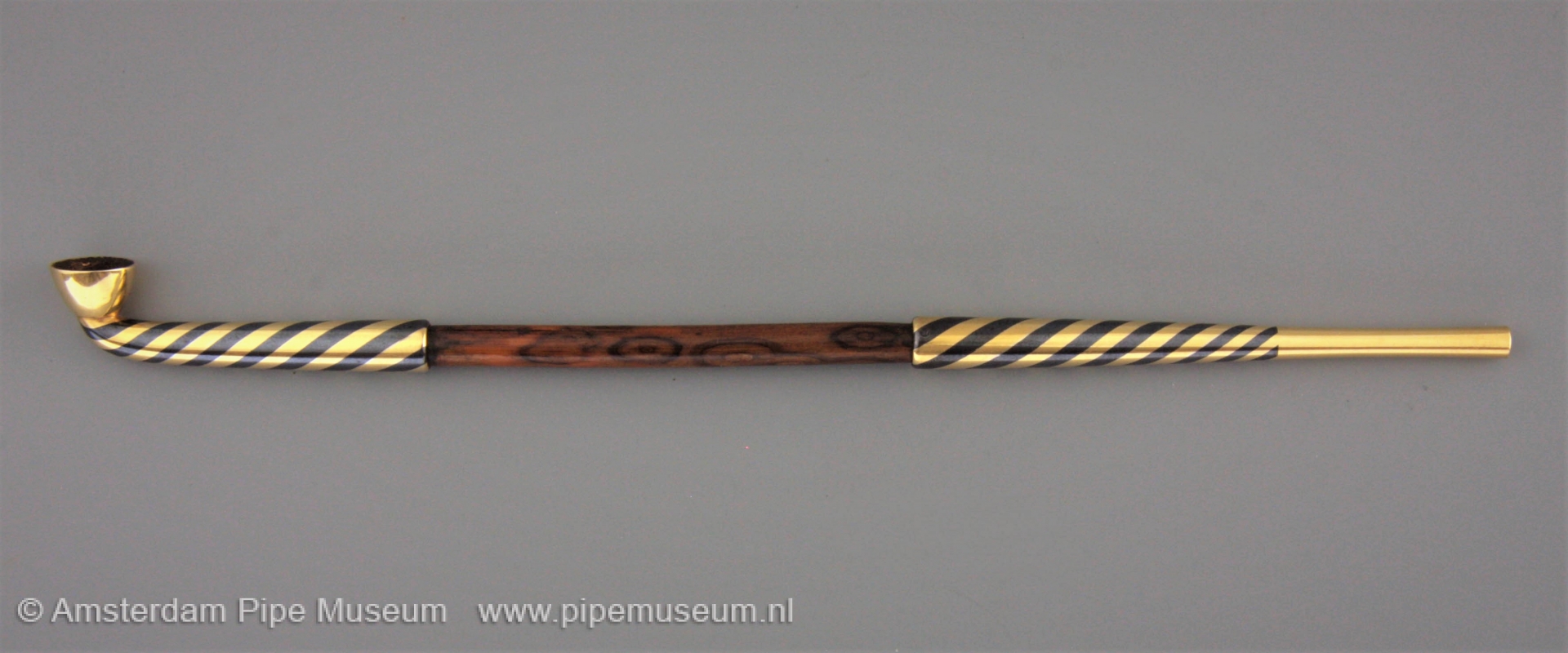
From the moment that smoking is known in Japan, a special type of pipe is used. It is the so-called kiseru, a pipe with a small funnel-shaped metal bowl and a bamboo stem. The mouthpiece is made of metal as well, mirror-like to the bowl part. The kiseru will remain popular for centuries, until it is replaced by the Western European wooden pipe somewhere between the two World Wars. At the same time, the taste experience of the Japanese smoker changes. The extremely finely cut, semi-heavy kiseru tobacco is exchanged for the flavoured European tobacco. The pipe smoker who wants a stronger taste can switch to the cigarette.
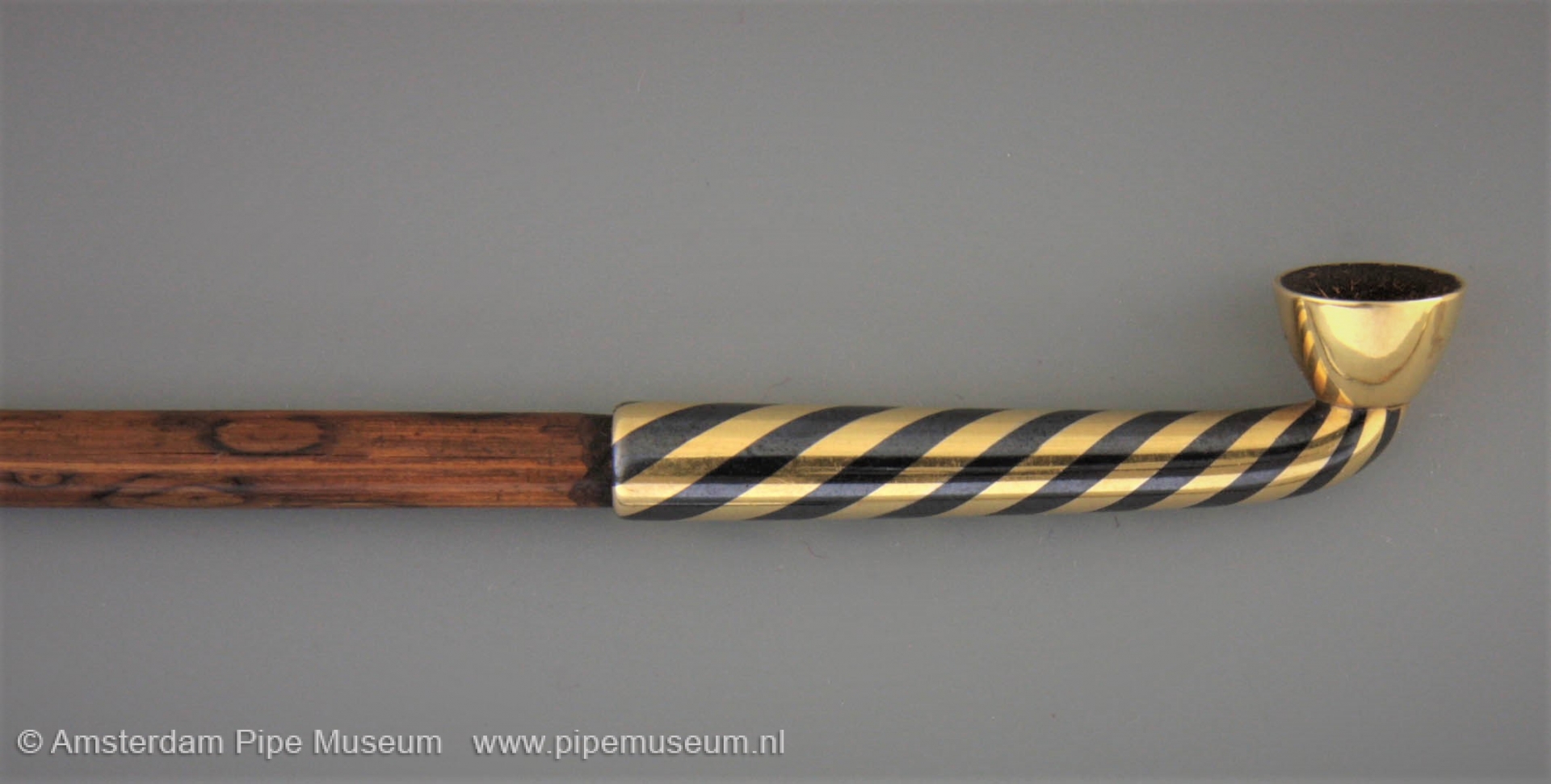
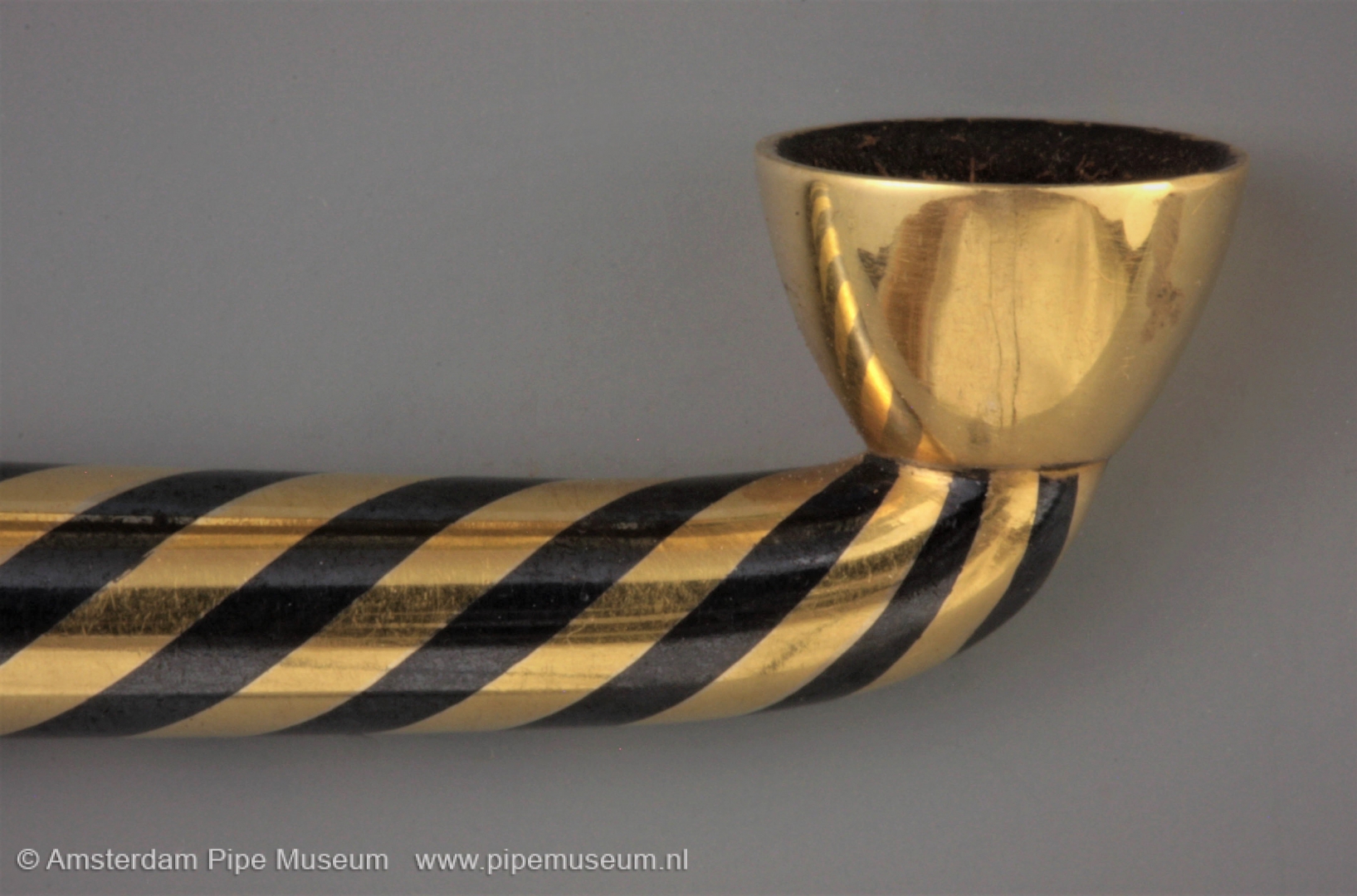
In Japan, both men and women smoke pipe, although there is clear distinction in the smoking instrument. The pipe for the man is significantly larger and coarser, the pipe for women is small and elegant. The appearance of the pipe is also strongly related to the smoker's status: rank and class consciousness of the user can be read from the pipe. A beautiful example of a particularly chic ladies' pipe is this golden kiseru. This pipe is one of the most precious species because of its exclusive look. With the most expensive material, no showy but a very modest result is obtained.
With this pipe, the golden surface is left undecorated except for a twisted line applied in a refined manner to both metal stem parts. This was done by engraving the metal, which was then filled in with an alloy of gold, copper and sulphur. This technique is called niello and is often seen in silver but rarely in gold. That burned-in mixture resulted in a special bluish tint. After polishing a beautiful smooth surface was obtained with an indestructible decoration.
A date for this pipe is difficult to give. The kiseru is hardly subject to development. Minimal differences in the bowl shape or mouthpiece are the only indication for more accurate dating. With this example, the straight unprofiled mouthpiece and the burnt decoration on the bamboo point to an earlier date. In this case, the Japanese would speak of a pipe from the Edo period. Although that period starts in 1603, this is a product from the last decades of that era, between 1850 and 1870.
Amsterdam Pipe Museum APM 19.672
A prestigious kiseru with carp

The Japanese pipe is called kiseru and is made of metal. It consists of a small pipe bowl in funnel shape with a short stem. The mouthpiece, also metal, is pushed together with the bowl onto a wooden or bamboo stem. The standard pipe is of undecorated base metal such as brass. For those who can afford, there are more luxurious kiserus to show off. At meetings, both private and public, the appearance of a nice pipe can underline the status of the owner. Especially in the nineteenth century the Japanese gratefully took advantage of fashion and status aspect.
The summit of luxury is shown in this silver pipe, decorated with gold inlays. The two stem parts of the pipe, those parts mounted onto the wooden stem, are richly adorned with a circular decoration of extraordinary craftsmanship. Main motive is a carp rinsing from the water, beautifully executed in solid, high grade gold that contrasts with the deeper surroundings in a contrasting tint. The foam crests on the waves are very aptly modelled with a strong embossing of the silver. As background, cane stems and leaves are applied in a much lighter relief.
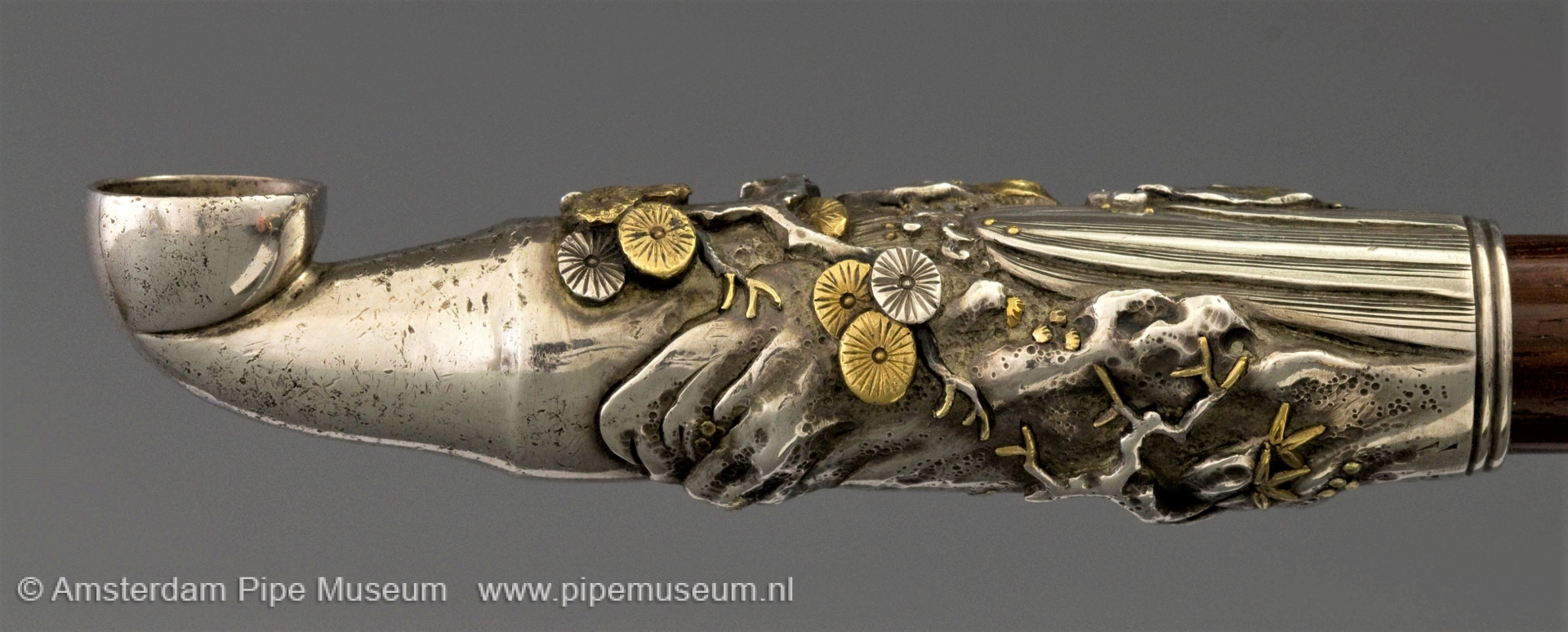
The section near the pipe bowl shows a landscape with mountains in the background. Because the reeds with foam crests are repeated along the bottom edge, it seems a continuation of the image on the mouthpiece. The waves and the reeds disappear unnoticed into rock soil with flowering prunes and other flower bearing plants accentuated in gold. The relatively high relief of the image enhances the depth effect in an extremely clever way. The continuity of the elements all around the stem and of course the close relationship between the two parts makes this pipe so intriguing.
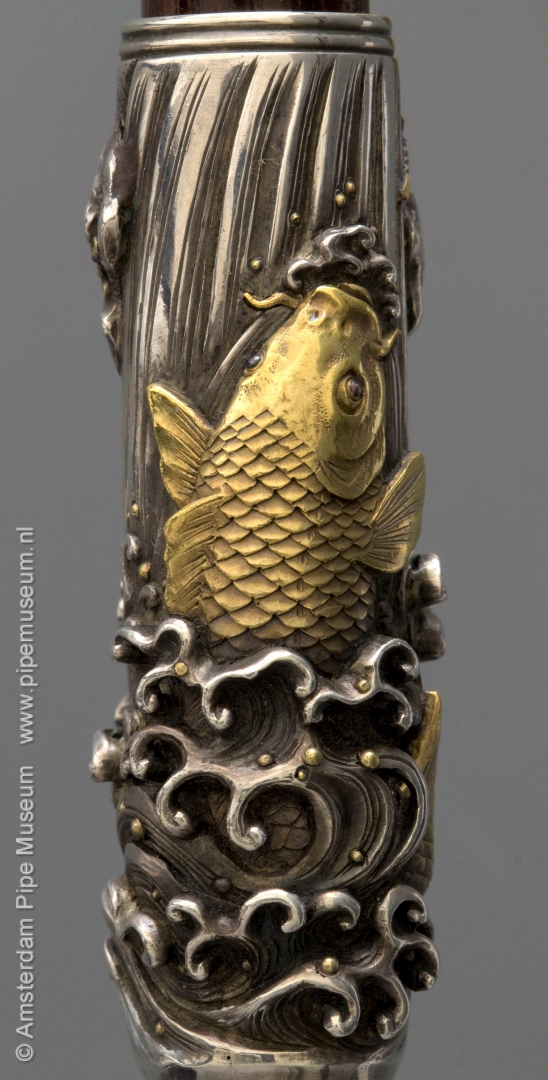
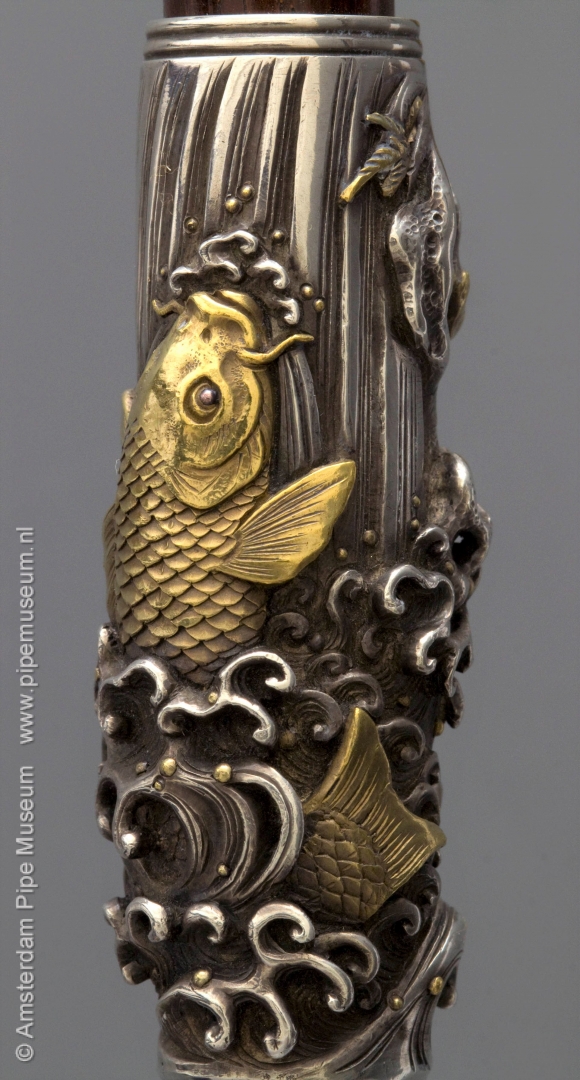
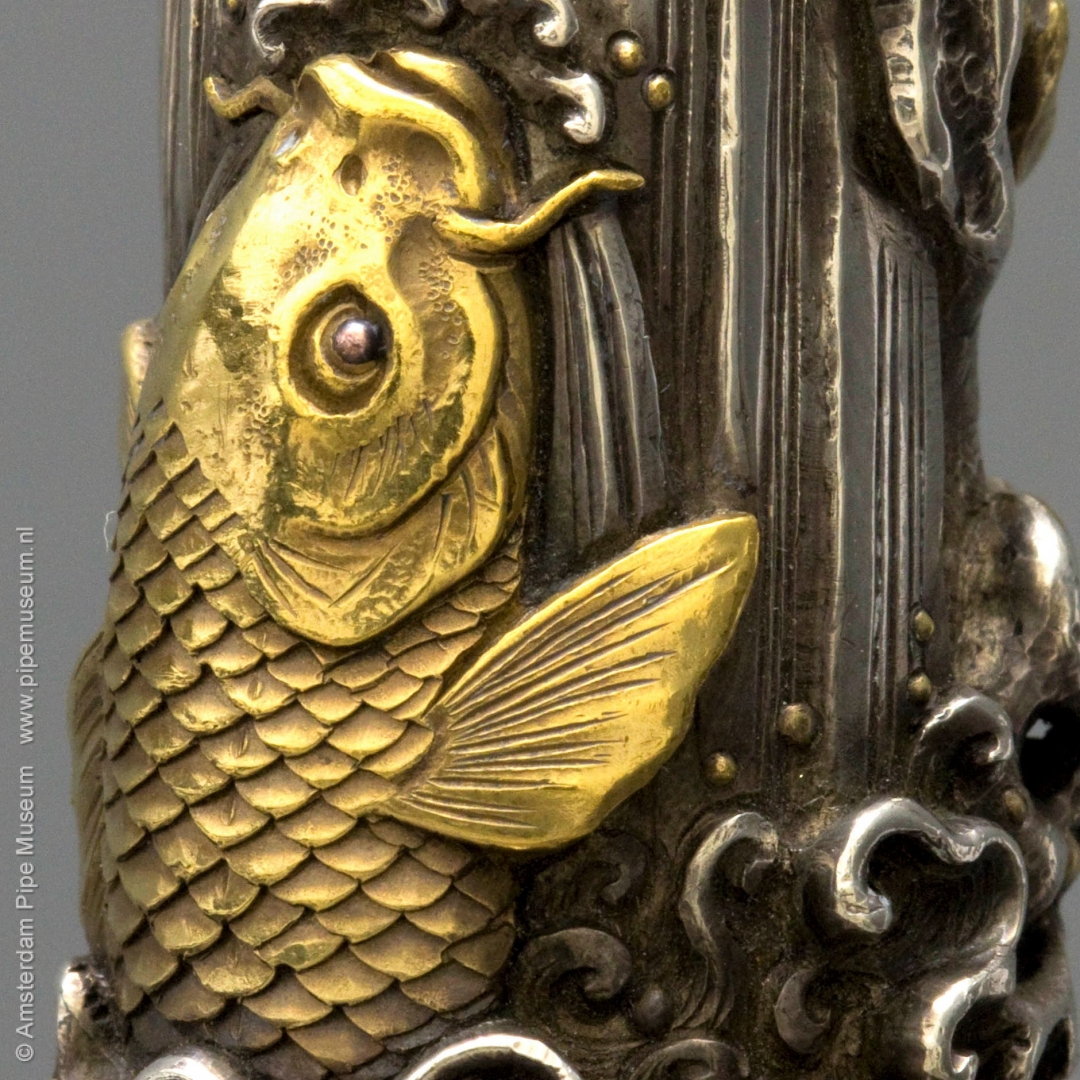
The main motive, the carp is the symbol of perseverance in Japan. According to tradition, carp, in Japanese Koi, would jump every year over the waterfalls in the Hunang-he to reach their spawning grounds. The story went on that when they crossed the rapids with the name Dragon gate they would turn into real dragons. The carp was therefore also a sign of success. The armour-like scales of the carp made him a symbol of martial spirit for the Japanese samurai.
Inlays of gold in silver was a favourite activity for the Japanese goldsmith who masters his profession. This pipe scores high as an esteemed example of the most expensive types of kiserus existing. Obviously, the question remains: who smoked from such a striking pipe? Rich smokers, that’s for sure, but whether they belong to the elite or to the nouveau riche, that is not betrayed by the pipe, but lies hidden in the sense of culture itself. For the Western European, such cultural patterns are difficult to read.
Amsterdam Pipe Museum APM 19.645
Bong with silver mounting
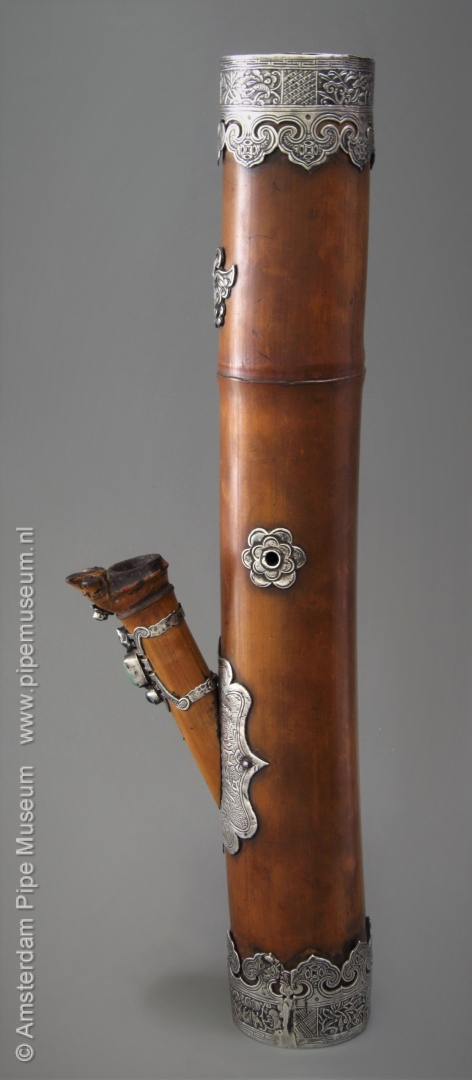
As a pipe, the bong has only become known in Western Europe by the hippies and their followers, especially for smoking hash. We are talking about a generally tubular pipe with a small bowl and a spacious smoke reservoir. In this smoke chamber, the smoke can cool down, which makes it taste better when inhaled. The bong is originally an Eastern invention. The Thai word baung is used for the cylindrical bamboo pipe to smoke marijuana, which is probably the origin of this characteristic pipe. The bong is now used throughout southeast Asia. The bamboo pipe is easy to make from material that is widely available, which is why the bong has become characteristic in all of South and Southeast Asia.
The original bong is a large bamboo tube with a thin tube inserted obliquely at one third from the bottom in which the bowl is placed. This bowl is usually made of the thickened knot of the bamboo and is therefore somewhat widened and thus better protected against burning-in. The bong is basically a water pipe, the water serves to cool the smoke. Especially with strong hash, this cooling makes the smoke less sharp.
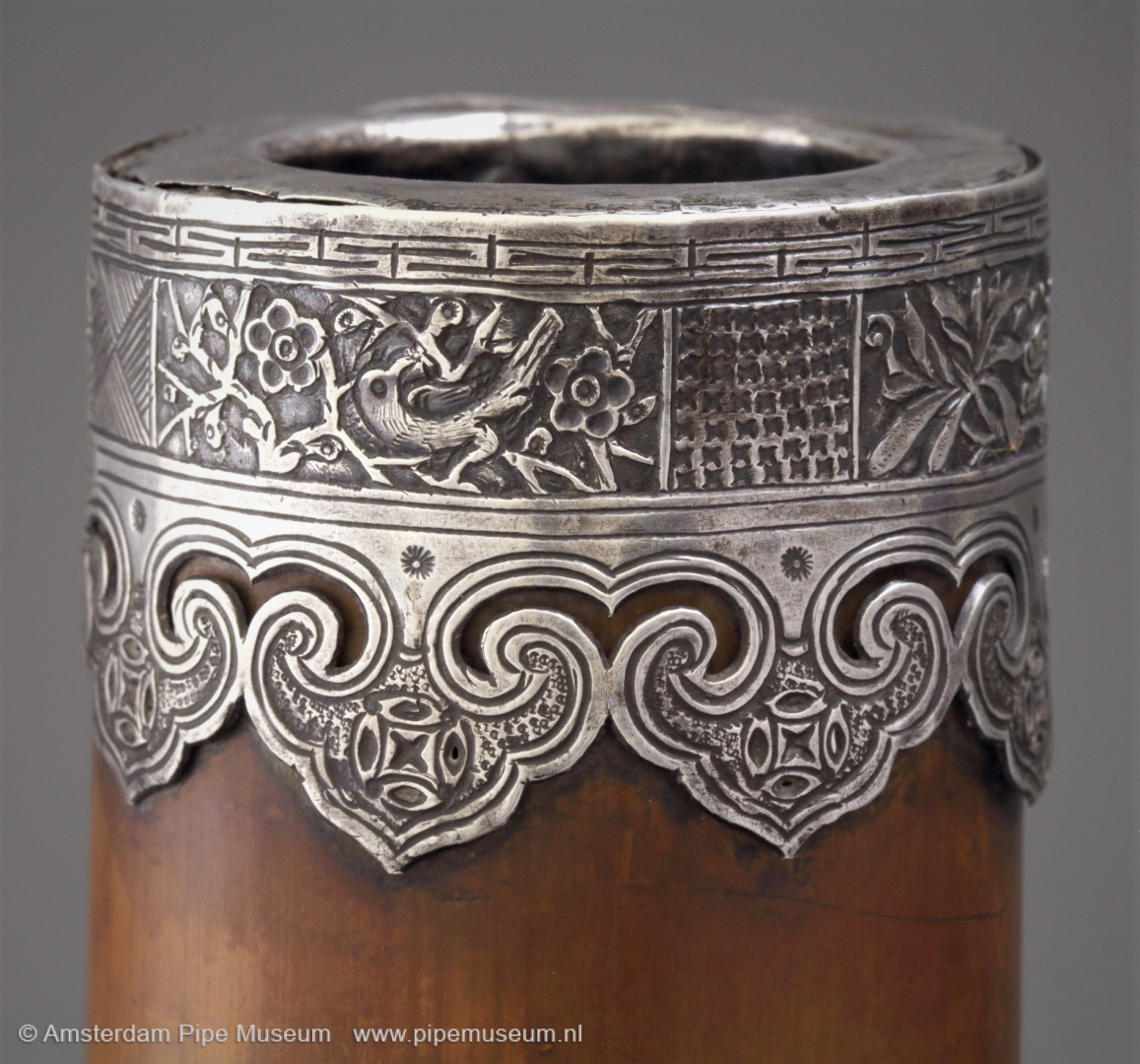
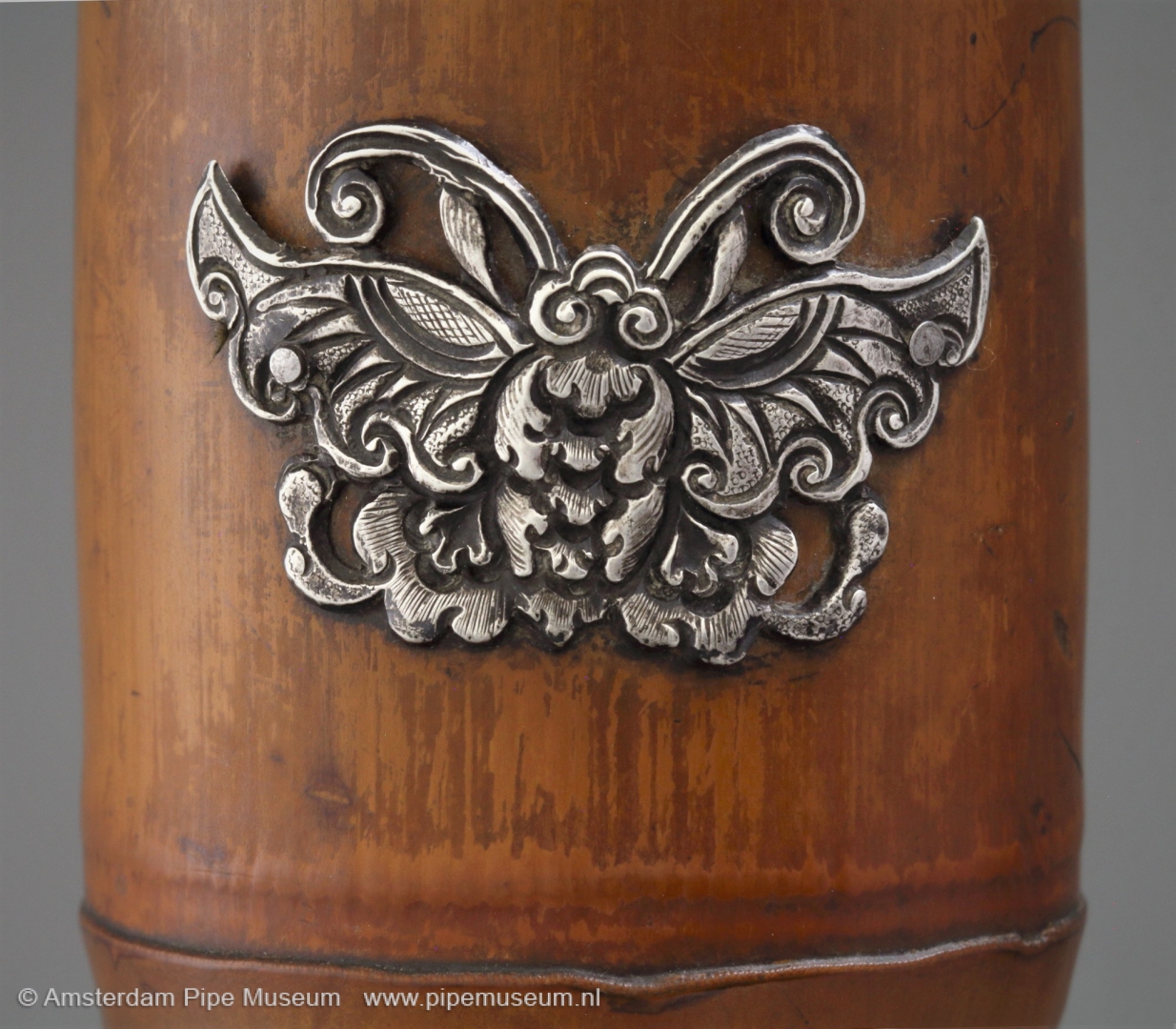
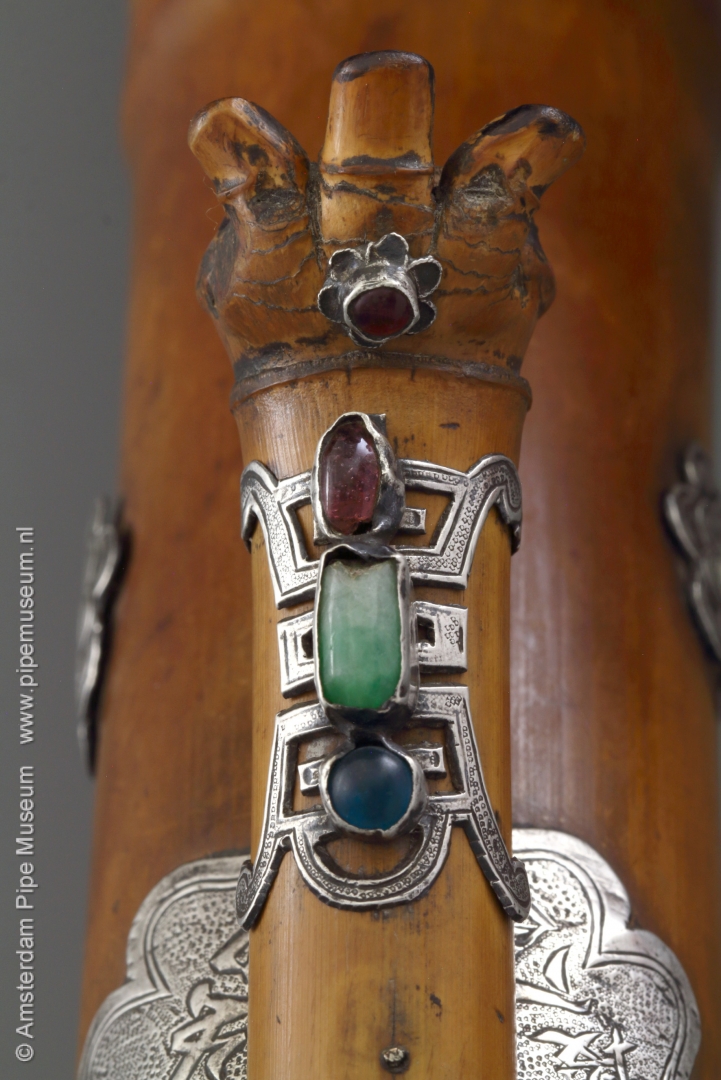
It is common to inhale the smoke, combined with false air. That is why one or two holes have been drilled in the bamboo somewhat higher in the smoke chamber, referred to as vent hole or simply air hole. You can cover it with your fingers or open it if you want to dilute the strong smoke. After smoking, the smoke is taken out of the pipe during the last draw by keeping these so-called vent holes open.
The bong discussed here is one of the more luxurious examples, although it clearly has the traditional shape. We see the two bamboo parts, the large tube shape has remained relatively modest in diameter, which indicates the use by a not too experienced smoker. The object is extra chic because silver fittings have been used as an embellishment. Both the base and the top are trimmed with a silver band with a beautifully contoured edge. This silver is decorated with typical Chinese motifs. Halfway through the thick tube we see two silver rosettes as a frame for the air hole, between which a tube as a connection. The inlet for the much thinner stem has a contoured rectangular cover plate with an inscription in Chinese characters on a granulated background. Above the pipe bowl, on the front, a stylized bat in embossed silver can be seen as an additional ornament. Finally, a decoration has been added directly under the bowl, based on a Chinese character, on which three decorative stones in purple, green and blue. They are the jewels of the pipe and underline the status of the smoker.
All in all, it is a fine example of a traditional local smoking instrument, albeit in a luxurious version. In Eastern cultures, smoking hash is mainly something for the less well-off, so luxury pipes like this one are rare. Most bongs are made of simple bamboo, sometimes with simple brass rings as reinforcement. They do not last long and they do not have to, they are made in large numbers for a low price. That does not apply to this embellished specimen.
Amsterdam Pipe Museum APM 23.576
A bat as a pommel
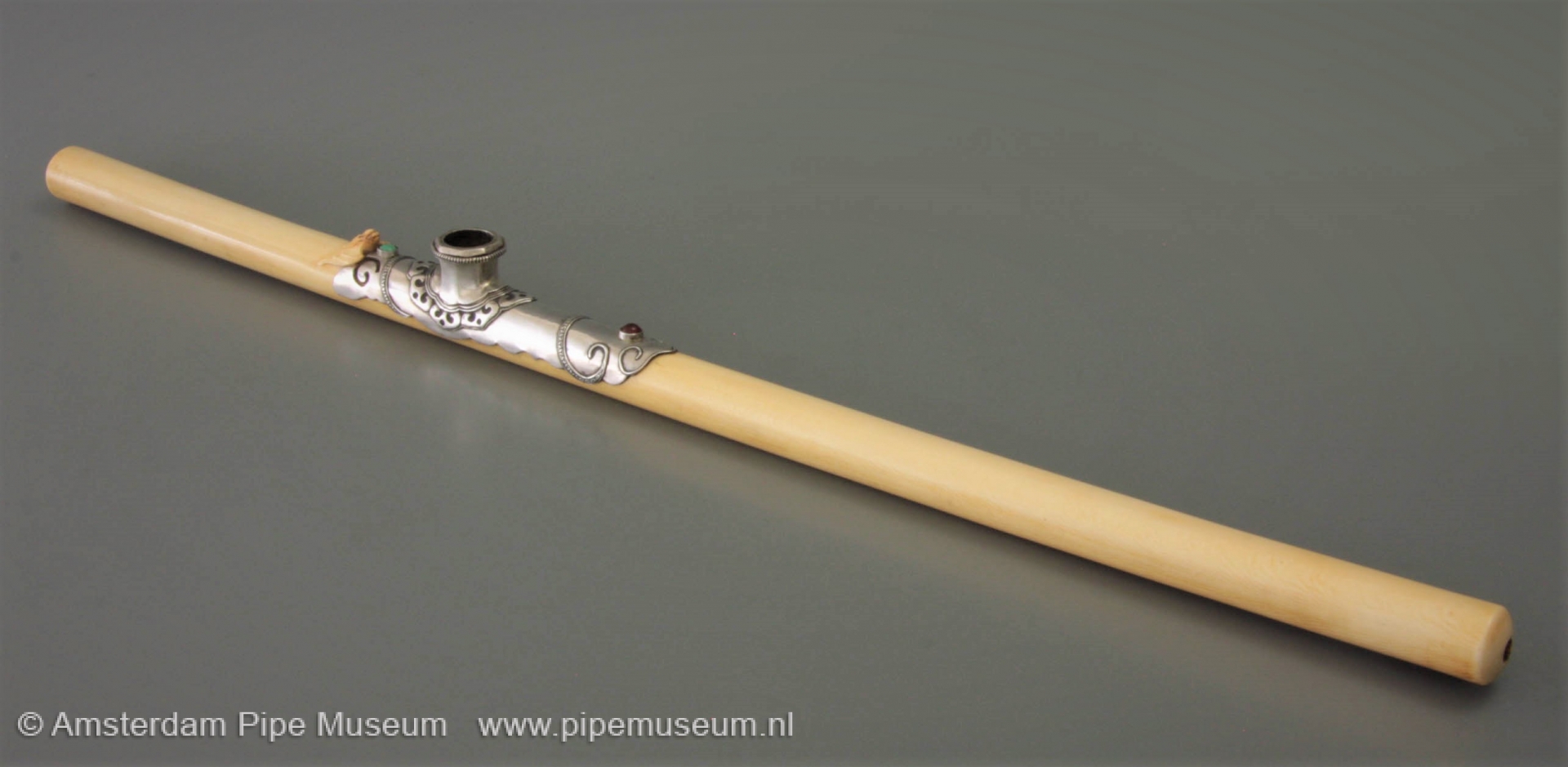
The Chinese opium pipe is characterized by a long tubular shape on which the pipe bowl or damper is placed at a right angle at three quarters from end. The stem end that is created behind the pipe bowl is used by the opium smoker as a handle to ajust the pipe exactly above the flame of the opium lamp. When heated, the opium vaporizes and the opium taker can inhale the vapour. Bamboo is the most suitable for such pipes because it it is hollow by nature, it absorbs moisture, but status objects exsists as well of which ivory is one of the favourites.
Characteristic of ivory opium pipes is that they show a slight bend, which has caused quite a few speculations. Some people claim that this is the bow of the tusk of the elephant. The carver would like to follow the grain structure of the dental material because this is not only efficient for the use of materials but also favourable for strength: the grain structure makes an object to crack less quickly. Unfortunately, that theory turns out to be incorrect because even the largest tusks are bent too strongly for a straight or almost straight opium pipe. It seems more likely that the pipe maker did not take into account the grain structure of the material because he preferred to make the product as straight as possible. The very slight bending of most opium pipes could have been caused by the autonomous action of the material.
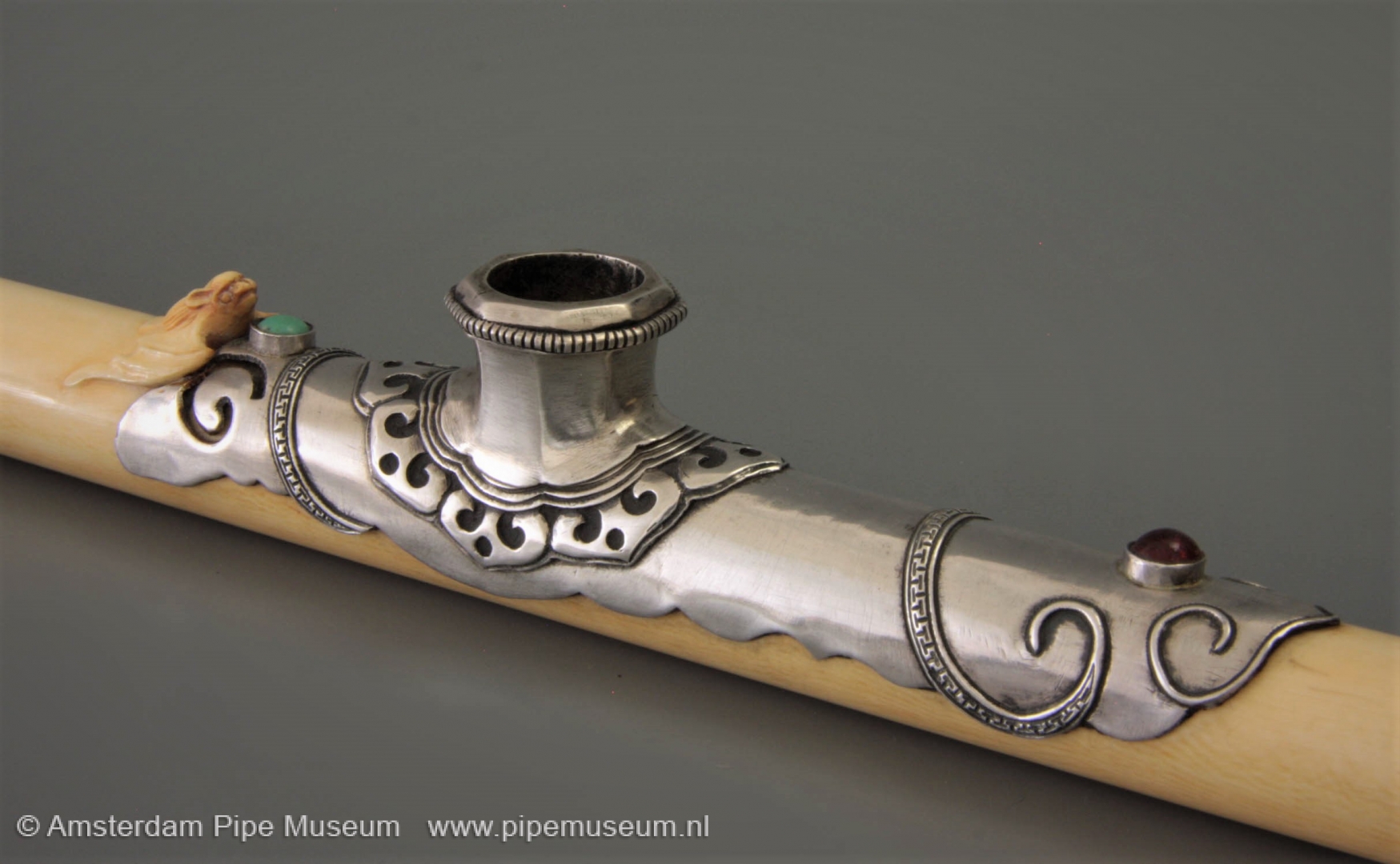
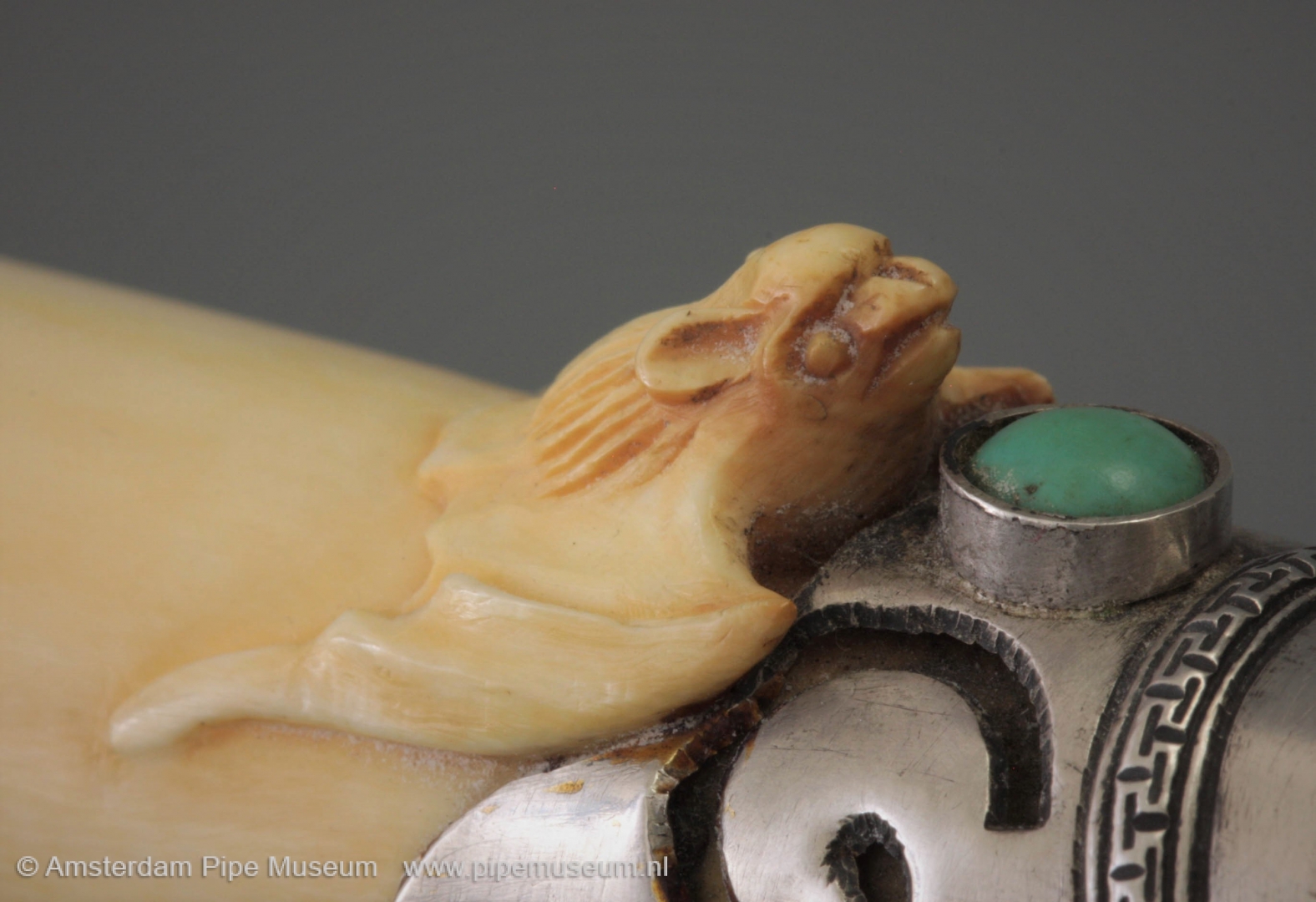
Enough about the theory of the straight and slightly bent opium pipe. The most special aspect of this pipe is not the minimal curvature but the pommel. Opium pipes are tilted to one side when smoked. In order to give more grip on the polished stem during this tilting, a pommel or finger rest is always applied to a serious opium pipe. In bamboo pipes this is usually the beautifully cut shoot of a side branch. In ivory this pommel is carved out of the ivory. When turning the tube shape of the pipe, a solid block was saved for this purpose, from which later on a figuration was cut by hand. In terms of subject, the Buddha is the most common in the ivory pipe. With this pipe, the carver choose for the heavenly rat, or in other words a bat with spread wings, for the Chinese an important sign for longevity, but also for joy and good fortune. The animal is shown in a slightly stylized manner and becomes the fixation point for the eye of everyone who looks at this pipe.
The bowl itself is connected to the pipe by a saddle. This connecting plate on the stem of the pipe opens into the centre in a circular holder for the pipe bowl. In accordance with the luxurious nature of this ivory pipe, in this case the saddle is made of silver. It has beautiful wavy contours and is further adorned with two semi-precious stones in circular setting: a cloudy green and a transparent brown-red stone.
All in all it is a simple yet chic pipe. Modest in appearance but exclusive in material use. It is clearly a pipe with a high status. Ivory pipes were not the best to use, but the most appreciated as a showpiece. We can notice the show factor of this pipe: it has been used minimally and therefore beautifully preserved. The origin is China, impossible to give a more specific region of origin. A qualification as being from the Canton region is often given but without proof. The date is between 1880 and 1900.
Amsterdam Pipe Museum APM 17.415
Maori pipe with mask head
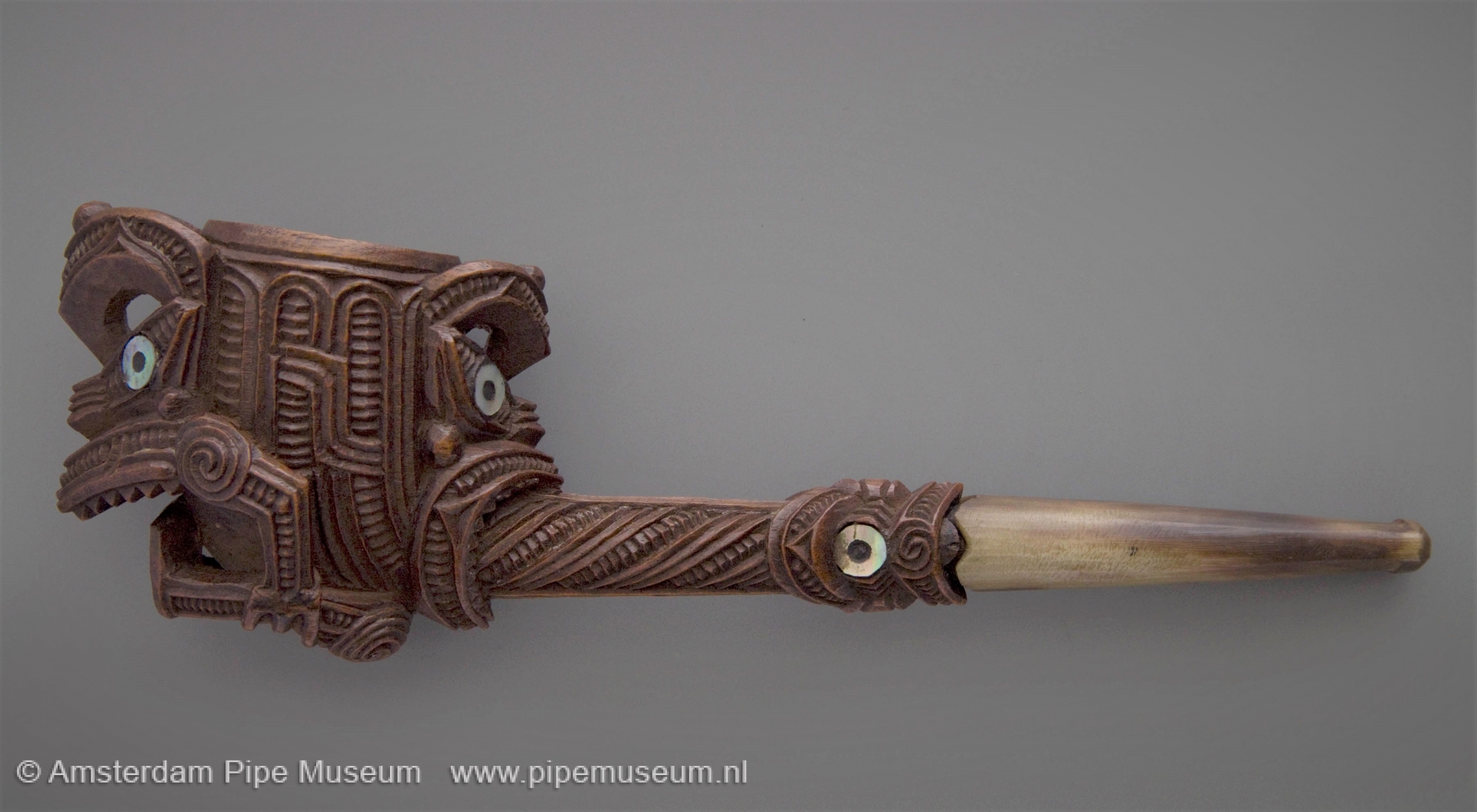
The people of New Zealand have shown great merit in carving wooden objects. They developed a style that is distinct from any other arts and crafts anywhere in the world. Main characteristic are the geometric motifs that overgrow the objects and in which the characteristic Maori masks can be recognized, together with stereotypical ornaments.
Proof of their artistic achievements is this tobacco pipe with figural bowl on a straight stem. In terms of shape, it is a pipe like many European briar wood pipes that are frequently made from 1860 onwards. Both the main shape and the material indicate this European basics. However, what makes the object unique is the decoration. On the stem side of the bowl we see in high relief a frightening mask head with striking wide open eyes under free-standing cut high eyebrows. The opened mouth full of sharp teeth bites around the base of the stem. A second mask has been cut on the back of the bowl, also with an open mouth with similar teeth. The Maori call this a wheku, a maker's face that, according to tradition, hangs on the facade of the community house to deter evil spirits. Arms sprout from a spiral behind the corners of the mouth, holding legs to the base of the bowl. The buttocks, like the shoulders, are shaped like spirals. Both sides of the bowl show a geometric braid pattern known as the rauponga pattern: rows of notches like dog teeth interspersed with parallel grooves, all intended as a stylized representation of the tree fern. This created a completely covered surface, not a spot on the pipe was left unadorned.
Even the stem is completely carved with a twisted rauponga pattern. The thickened stem end also has two eyes, so with some imagination you can see the head of a young bird in it. All six eyes in the scene are inlaid with mother-of-pearl, with black pupils in the center. The Maori use the mother of pearl of abalones for this, which they themselves refer to as paua. In English literature it is called abalone, but for clarity we also give the Latin name haliotis. The tobacco pipe is mounted with a straight buffalo horn stem with flattened bite and knot, a typical European element. The start of the separate stem is very attractively contoured, which we have never seen in Europe.
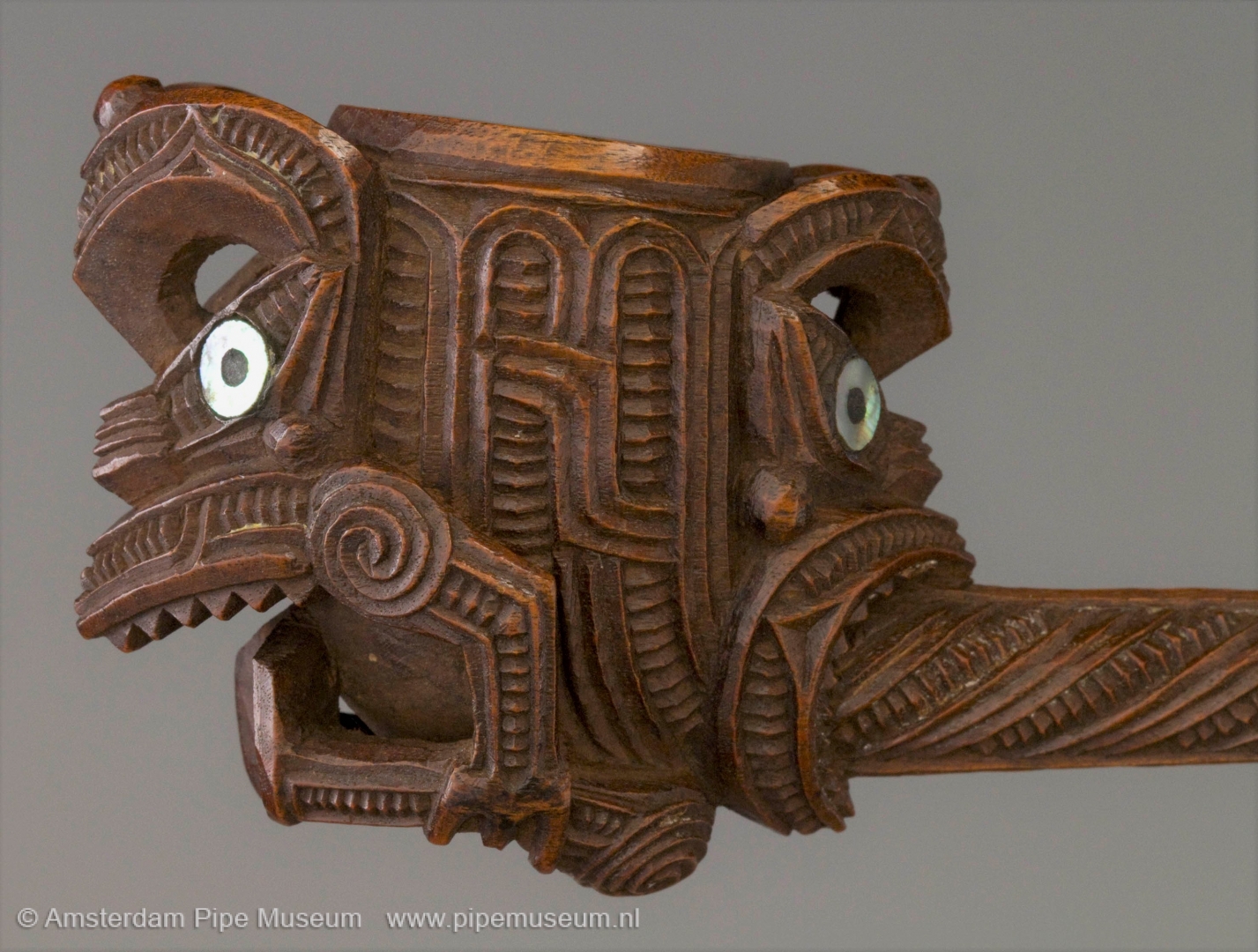
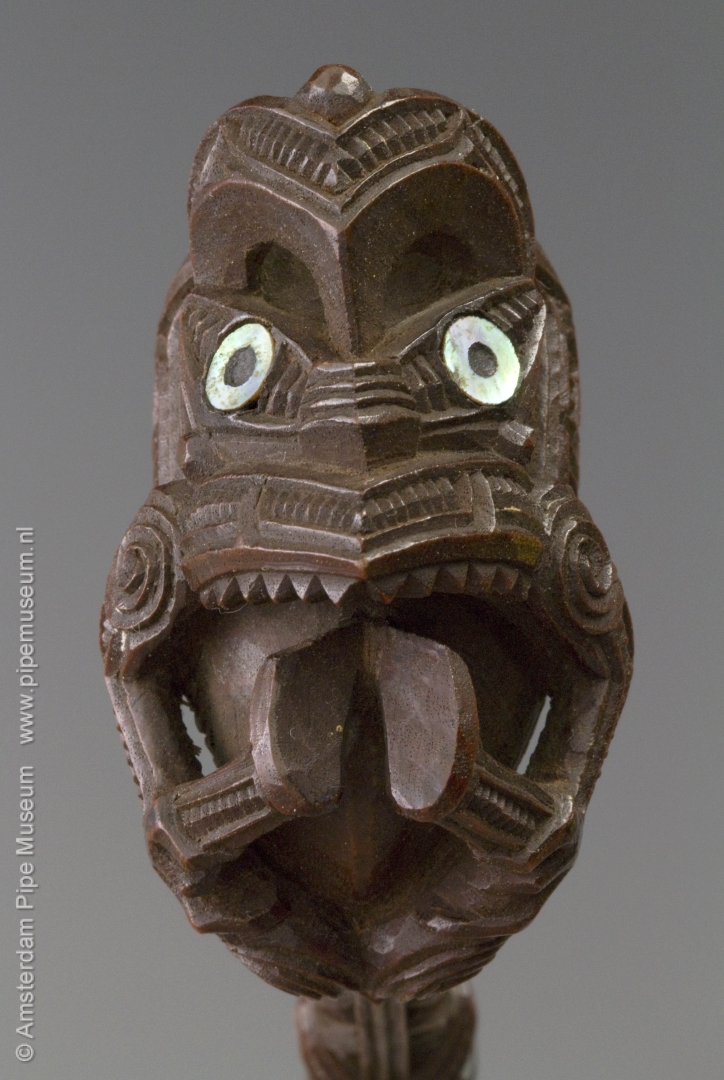
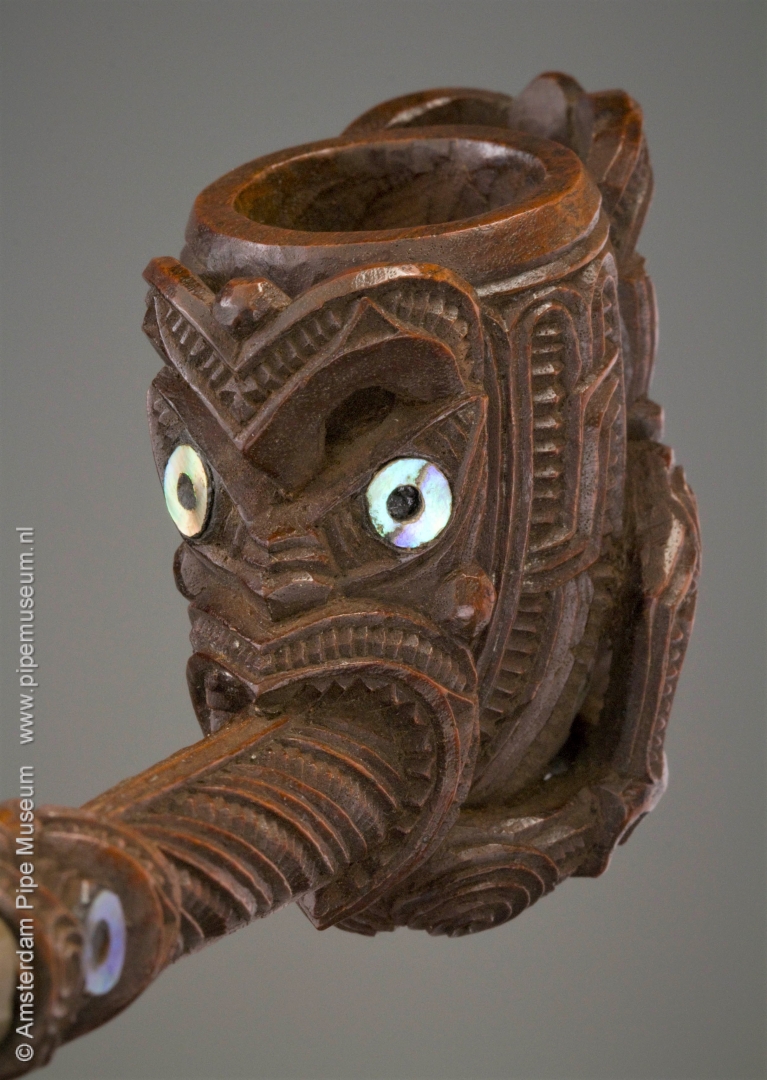
Pipe enthusiast and connoisseur Alfred Dunhill depicts an object in his The Pipe Book that shows striking resemblance. He speaks of English style as opposed to pipes made by the Maori that are not influenced by the English export pipes. Dunhill made a drawing of the pipe from the original that was already in the British Museum at the time. That object arrived there in 1896, with an exceptionally detailed provenance. The pipe was once owned by the Maori king Tawhiao (reigned 1860-1894), who gave it as a present to Julius von Haast, the German director of the Christchurch Museum. He in turn passed the pipe on to Enrico Giglioli, his colleague from the Royal Museum of Natural History in Florence. From Italy, the object eventually ended up in the British Museum in 1896.
As if this is not precise enough, all owners have also noted the maker of this pipe: Patoromu Tamatea of the Ngati Tamateatutahi clan, part of the larger Te Arawa people. The date is said to be in the 1870s. The Te Awara is one of the Maori people that has its area in the middle of the North Island, from the coast to Lake Rotorua. Due to great threats from neighboring tribes, the Te Awara decided from 1860 to work more closely with the English colonists in order to benefit from their protection. This went hand in hand with a fusion of their own animistic faith with the Anglican. This assimilation has undoubtedly also led to the introduction to the quintessentially English briar pipes, which form the base of our example. Given the striking resemblance between the two pipes, one in the British Museum, the other in Amsterdam, we can safely attribute our pipe to the same carver and having the same date.
Literature: Don Duco, Tobacco pipes of the Maori, Amsterdam, 2010.
Amsterdam Pipe Museum APM 22.288